Paul van Yperen's Blog, page 353
March 2, 2016
Raphael
Raphael (1943) is one of the most important singers in the Spanish language of the second half of the 20th century. Twice, he represented Spain at the Eurovision Song Contest. He opened the door and paved the way to the flood of Spanish singers that followed on the wake of his enormous success. Raphael is also a television, film and theatre actor, who appeared in a popular series of Spanish film musicals during the late 1960s.
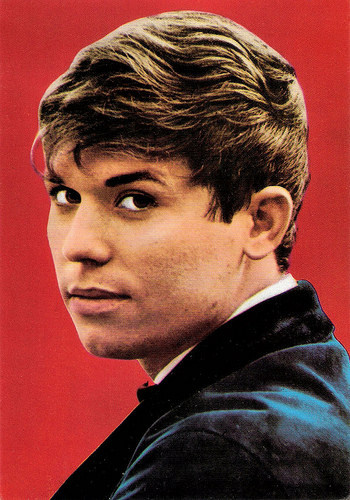
Spanish postcard by Postal Oscarcolor, no. 570. Photo: Hispavox.
The Nightingale of Linares
Raphael was born Miguel Rafael Martos Sánchez in Linares, Spain, in 1943. He is nicknamed both ‘El Ruiseñor de Linares’ (The Nightingale of Linares) and ‘El Divo de Linares’ (The Divo from Linares) but is also known as ‘El Niño’. His family moved to Madrid when he was nine months old, and he started singing when he was just three years-old. He joined a children's choir at age four. W
hen he was 9, Raphael was recognised as the best child voice in Europe at a contest in Salzburg, Austria. Raphael began his professional career by signing with the Dutch record label Philips. To distinguish himself, he adopted the ‘ph’ of the company's name and christened himself 'Raphael'.
His first singles were Te voy a contar mi vida and A pesar de todo’. Raphael adopted his own peculiar singing style from the beginning; he is known for acting each one of his songs while on stage, emphasising his gestures with high dramatic effect. It is not unusual for Raphael to ad lib lyrics as to localise a song depending on the venue he's singing at, wear Latin American peasant costumes and dance folk dances within a song, kicking and demolishing a mirror, or doing the moves of a flamenco dancer or a bullfighter onstage.
Raphael also possesses a wide vocal range, which he often used in the beginning of his career as to evoke a choirboy approach to some songs. When he was nineteen, he won first, second and third awards at the Benidorm International Song Festival, Spain, 1962. He signed a contract with Hispavox recording company, and began a long artistic relationship with the musical director of this label, the orchestrator Waldo de los Ríos and intensify the partnership with songwriter Manuel Alejandro.
In 1966 and 1967 he represented Spain at the Eurovision Song Contest, singing Yo soy aquél and Hablemos del amor and placing both 7th and 6th position. This served as a turning point in Raphael's career, making him an international star. He travelled and performed worldwide in Europe, Latin America, the United States, Russia and Japan.
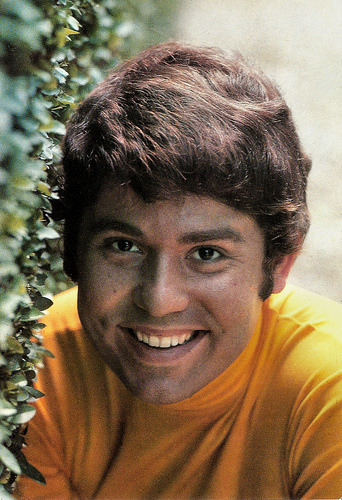
Spanish postcard by Bergas Industrias Graficas, no. 886.
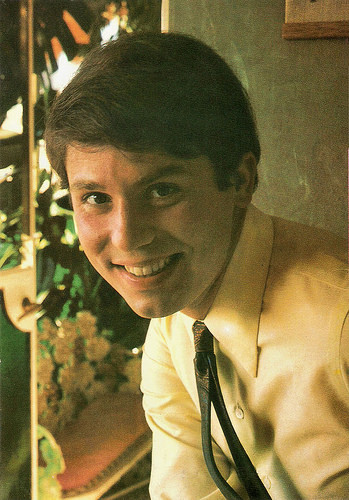
Spanish postcard by Postal Oscarcolor, Hospitalet, no. 751, 1967.
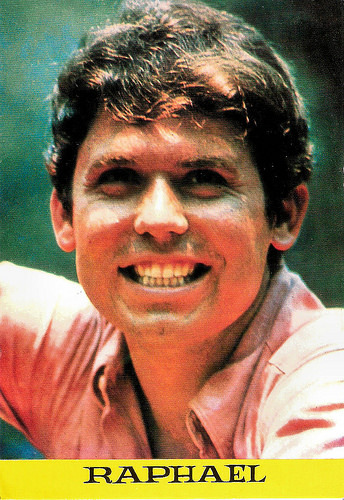
Spanish postcard by Bergas Industrias Graficas, no. 793.
The World of Raphael
Raphael also had a lucrative film career. He made his film debut as a singer in Las gemelas/The Twins (Antonio del Amo, 1963). As an actor he had his breakthrough in the musical Cuando tú no estás/When you are not here (Mario Camus, 1966). In the film's first half Raphael plays himself, trying to find fame and fortune as a popular singer in Spain until he teams up with an up and coming Spanish composer (based on Raphael's real life composer Manuel Alejandro) and becomes a popular singer.
Alan Bobet at IMDb : “This is the first and best in my opinion of the Spanish musical films starring Spanish singing sensation, Raphael in his first starring role and the first of 3 Raphael film musicals directed by Mario Camus, who would be one of Spain's top film directors in the 1970's.” The other two were Al ponerse el Sol/At Sunset (Mario Camus, 1967) and Digan lo que digan/Let Them Talk (Mario Camus, 1968), which was filmed in Argentina.
Other popular films with Raphael were El golfo/The Gulf (Vicente Escrivá, 1969), with Shirley Jones, El ángel/The Angel (Vicente Escrivá, 1969) with Anna Gaël, Sin Un Adiós/Without a goodbye (Vicente Escrivá, 1970), with Lesley-Anne Down and partially filmed in England, and Volveré a nacer/I will be born (Javier Aguirre, 1972) with Héctor Suárez.
In 1975, Raphael began his own successful program on Spanish Television called El Mundo de Raphael (The World of Raphael), where he sang with international stars. He also had a radio program, where he and his wife spoke with and interviewed outstanding personalities, and he starred in soap operas, starting with the Mexican production Donde termina el camino (1978).
Raphael succeeded in the early 1980s with songs such as ¿Qué tal te va sin mí? and Como yo te amo. During 1984 and 1985 he recorded two albums with songs written by José Luis Perales. In 1987 he left Hispavox and signed a contract with Columbia (now Sony Music). In 1991 he had a hit with Escándalo in Spain, Latin America, and in Japan, where it reached number one.
At the end of the 1990s, after ending a contract with PolyGram, he went back to EMI. In 1998 the artist published the first part of his memoirs titled ¿Y mañana qué?, from his childhood until his marriage in 1972. In 2000, Raphael took the title role in the Spanish version of the stage musical Jekyll & Hyde, with great success.
Recently, he returned to the screen in the dark comedy Mi gran noche/My Great Night (Álex de la Iglesia, 2015). Since 1972, Raphael is married to aristocrat, journalist and writer Natalia Figueroa. They have three children: Jacobo, Alejandra and Manuel.
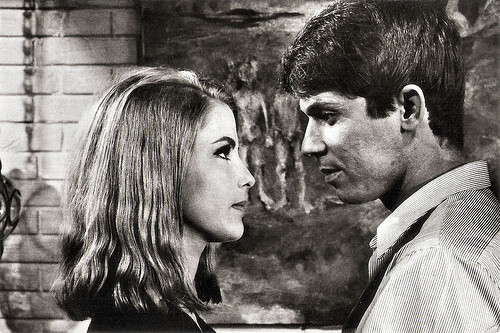
Romanian postcard by Casa Filmului Acin, no. 16. Photo: publicity still for Cuando tú no estás//When you are not here (Mario Camus, 1966) with Marie José Alphonso.
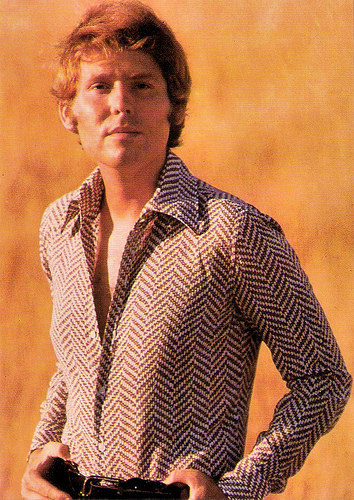
Spanish postcard by Bergas Industrias Graficas, no. 1001.
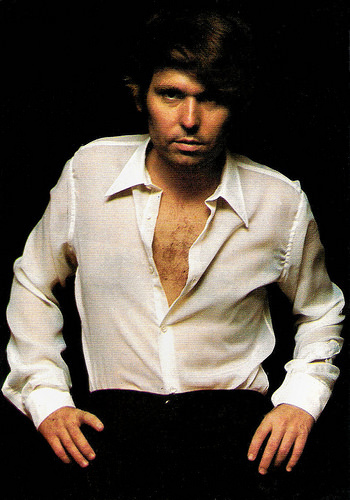
Spanish postcard by Bergas Industrias Graficas, no. 1004.
Raphael sings Yo soy aquel. Source: Vad Feel (YouTube).
Raphael sings Mi Gran Noche (1967). Source: Evolution (YouTube).
Trailer Mi Gran Noche (2015). Source: Universal Spain (YouTube).
Sources: Alan Bobet (IMDb), Wikipedia and .

Spanish postcard by Postal Oscarcolor, no. 570. Photo: Hispavox.
The Nightingale of Linares
Raphael was born Miguel Rafael Martos Sánchez in Linares, Spain, in 1943. He is nicknamed both ‘El Ruiseñor de Linares’ (The Nightingale of Linares) and ‘El Divo de Linares’ (The Divo from Linares) but is also known as ‘El Niño’. His family moved to Madrid when he was nine months old, and he started singing when he was just three years-old. He joined a children's choir at age four. W
hen he was 9, Raphael was recognised as the best child voice in Europe at a contest in Salzburg, Austria. Raphael began his professional career by signing with the Dutch record label Philips. To distinguish himself, he adopted the ‘ph’ of the company's name and christened himself 'Raphael'.
His first singles were Te voy a contar mi vida and A pesar de todo’. Raphael adopted his own peculiar singing style from the beginning; he is known for acting each one of his songs while on stage, emphasising his gestures with high dramatic effect. It is not unusual for Raphael to ad lib lyrics as to localise a song depending on the venue he's singing at, wear Latin American peasant costumes and dance folk dances within a song, kicking and demolishing a mirror, or doing the moves of a flamenco dancer or a bullfighter onstage.
Raphael also possesses a wide vocal range, which he often used in the beginning of his career as to evoke a choirboy approach to some songs. When he was nineteen, he won first, second and third awards at the Benidorm International Song Festival, Spain, 1962. He signed a contract with Hispavox recording company, and began a long artistic relationship with the musical director of this label, the orchestrator Waldo de los Ríos and intensify the partnership with songwriter Manuel Alejandro.
In 1966 and 1967 he represented Spain at the Eurovision Song Contest, singing Yo soy aquél and Hablemos del amor and placing both 7th and 6th position. This served as a turning point in Raphael's career, making him an international star. He travelled and performed worldwide in Europe, Latin America, the United States, Russia and Japan.

Spanish postcard by Bergas Industrias Graficas, no. 886.

Spanish postcard by Postal Oscarcolor, Hospitalet, no. 751, 1967.

Spanish postcard by Bergas Industrias Graficas, no. 793.
The World of Raphael
Raphael also had a lucrative film career. He made his film debut as a singer in Las gemelas/The Twins (Antonio del Amo, 1963). As an actor he had his breakthrough in the musical Cuando tú no estás/When you are not here (Mario Camus, 1966). In the film's first half Raphael plays himself, trying to find fame and fortune as a popular singer in Spain until he teams up with an up and coming Spanish composer (based on Raphael's real life composer Manuel Alejandro) and becomes a popular singer.
Alan Bobet at IMDb : “This is the first and best in my opinion of the Spanish musical films starring Spanish singing sensation, Raphael in his first starring role and the first of 3 Raphael film musicals directed by Mario Camus, who would be one of Spain's top film directors in the 1970's.” The other two were Al ponerse el Sol/At Sunset (Mario Camus, 1967) and Digan lo que digan/Let Them Talk (Mario Camus, 1968), which was filmed in Argentina.
Other popular films with Raphael were El golfo/The Gulf (Vicente Escrivá, 1969), with Shirley Jones, El ángel/The Angel (Vicente Escrivá, 1969) with Anna Gaël, Sin Un Adiós/Without a goodbye (Vicente Escrivá, 1970), with Lesley-Anne Down and partially filmed in England, and Volveré a nacer/I will be born (Javier Aguirre, 1972) with Héctor Suárez.
In 1975, Raphael began his own successful program on Spanish Television called El Mundo de Raphael (The World of Raphael), where he sang with international stars. He also had a radio program, where he and his wife spoke with and interviewed outstanding personalities, and he starred in soap operas, starting with the Mexican production Donde termina el camino (1978).
Raphael succeeded in the early 1980s with songs such as ¿Qué tal te va sin mí? and Como yo te amo. During 1984 and 1985 he recorded two albums with songs written by José Luis Perales. In 1987 he left Hispavox and signed a contract with Columbia (now Sony Music). In 1991 he had a hit with Escándalo in Spain, Latin America, and in Japan, where it reached number one.
At the end of the 1990s, after ending a contract with PolyGram, he went back to EMI. In 1998 the artist published the first part of his memoirs titled ¿Y mañana qué?, from his childhood until his marriage in 1972. In 2000, Raphael took the title role in the Spanish version of the stage musical Jekyll & Hyde, with great success.
Recently, he returned to the screen in the dark comedy Mi gran noche/My Great Night (Álex de la Iglesia, 2015). Since 1972, Raphael is married to aristocrat, journalist and writer Natalia Figueroa. They have three children: Jacobo, Alejandra and Manuel.

Romanian postcard by Casa Filmului Acin, no. 16. Photo: publicity still for Cuando tú no estás//When you are not here (Mario Camus, 1966) with Marie José Alphonso.

Spanish postcard by Bergas Industrias Graficas, no. 1001.

Spanish postcard by Bergas Industrias Graficas, no. 1004.
Raphael sings Yo soy aquel. Source: Vad Feel (YouTube).
Raphael sings Mi Gran Noche (1967). Source: Evolution (YouTube).
Trailer Mi Gran Noche (2015). Source: Universal Spain (YouTube).
Sources: Alan Bobet (IMDb), Wikipedia and .
Published on March 02, 2016 22:00
March 1, 2016
Imported from the USA: Kim Hunter
American actress Kim Hunter(1922-2002) had her breakthrough in the cinema with the classic British film A Matter of Life and Death (1946). In 1952 she won an Oscar for her part as Stella in A Streetcar Named Desire (1951). In the McCarthy she was blacklisted as being a Communist sympathizer, but in the 1960s she was cleared from the unjustly accusations.
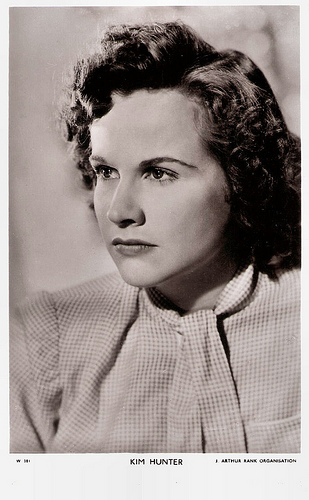
British postcard in the Picturegoer Series, London, no. W. 381. Photo: J. Arthur Rank Organisation.
A Matter of Life and Death
Kim Hunter was born as Janet Cole in Detroit, Michigan, USA, in 1922. Her father, Donald Cole, was a consulting engineer, and died in 1926 when Kim was only 3 years old. Her mother, Grace Lind, once performed as a concert pianist. She had one brother who was eight years older than she, and she was educated at Miami Beach High.
According to Joseph Collura in Classic Images , Kim was quiet and painfully shy as a child and overcame it through the guidance of a local dramatics teacher, a Mrs. Carmine. Included were diction, voice and posture lessons. She studied at the Actors Studio and her first professional stage appearance was as Penny in Penny Wise in 1939. Then, she joined a repertory group called Theatre of Fifteen, but it disbanded in 1942 when WWII took away most of its male members.
She was appearing in the 1942 Pasadena Playhouse production of Arsenic and Old Lace when she was discovered by an RKO talent hunter who signed her to a seven-year contract for David O. Selznick's company. Selznick suggested she change her first name to Kim and a RKO secretary suggested the last name of Hunter. She only did loan-outs for the two years she was under contract.
Hunter's first film role as a lone-out was in the Film Noir, The Seventh Victim (Mark Robson, 1943). Her only work inside the Selznick Studio was three days of screen tests for Alfred Hitchcock on Spellbound, sitting in for Ingrid Bergman as actors were tested for minor roles. Even though she was only shot from behind her head, she impressed Hitchcock, who had lunch with her.
A year later he recommended her to Michael Powell and Emeric Pressburger, who cast her in a bit role in the American version of A Canterbury Tale (1944) and then gave her the female lead role opposite David Niven in A Matter of Life and Death (1946).
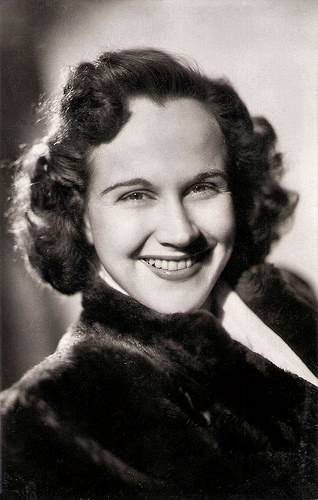
Vintage autograph card.
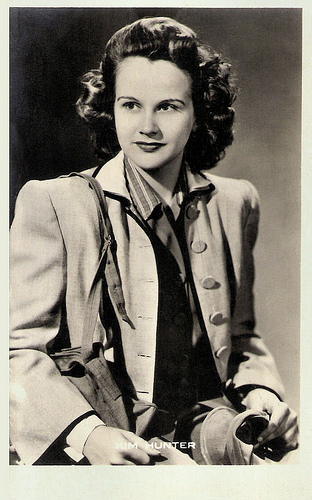
Dutch postcard.
A Streetcar Named Desire
In 1947, Kim Hunter made her Broadway debut as Stella in A Streetcar Named Desire. The production was the 1947-1948 season's success and for her role she won the Critics Circle and Donaldson awards.
A few years later, Irene Mayer Selznick recommended Kim for her reprise role of Stella opposite Vivien Leigh and Marlon Brando in the film A Streetcar Named Desire (Elia Kazan, 1951), for which she won a Golden Globe and an Oscar as Best Supporting Actress Oscar in 1952. Hunter was in New York rehearsing for the Horton Foote play, The Chas when the Oscar ceremony was held. Bette Davis accepted in her place.
Hunter was a political activist. She signed several civil rights petitions and was a sponsor of a 1949 World Peace Conference in New York. This triggered her label of being a Communist sympathizer, for which she was blacklisted in films and TV even though she never even held pro-Communist views. Her testimony to the New York Supreme Court in 1962 against the publishers of Red Channels helped pave the way for clearance of many performers unjustly accused of Communist connections.
In 1956, she returned to the cinema opposite Bette Davis in Storm Center (Daniel Tarradash, 1956). Other films were The Young Stranger (John Frankenheimer, 1957), and Lilith (Robert Rossen, 1964) with Jean Seberg . She also played Zira, the sympathetic chimpanzee scientist in Planet of the Apes (Franklin J. Schaffner, 1968) and two sequels, but she was mostly seen on stage of on television.
On TV she played a guest starring role in an episode of the action series Baretta (1976), for wich she was nominated for an Emmy award. In 1980, she was also nominated for a Daytime Emmy Award for her work on the long-running soap The Edge of Night.
In the cinema she could be seen in the Italian horror film Due occhi diabolici/Two Evil Eyes (Dario Argento, George A. Romero, 1990) and Clint Eastwood ’s Midnight in the Garden of Good and Evil (1997).
Kim Hunter was married twice. In 1944 she married Marine Captain William A. Baldwin, with whom she had a daughter, Kathryn Deirdre Baldwin. They marriage ended in a divorce in 1946. In 1951 she married Robert Emmett, with whom she had a son, Sean Emmett (1954). They stayed married till his death in 2000. Kim Hunter died of a heart attack in 2002 in New York City, some two months shy of her 80th birthday.
Opening sequence of A Matter of Life and Death (1946). Source: crmsonsky (YouTube).
Trailer A Streetcar Named Desire (1951). Source: AgelessTrailers (YouTube).
Sources: (IMDb), Wikipedia and .

British postcard in the Picturegoer Series, London, no. W. 381. Photo: J. Arthur Rank Organisation.
A Matter of Life and Death
Kim Hunter was born as Janet Cole in Detroit, Michigan, USA, in 1922. Her father, Donald Cole, was a consulting engineer, and died in 1926 when Kim was only 3 years old. Her mother, Grace Lind, once performed as a concert pianist. She had one brother who was eight years older than she, and she was educated at Miami Beach High.
According to Joseph Collura in Classic Images , Kim was quiet and painfully shy as a child and overcame it through the guidance of a local dramatics teacher, a Mrs. Carmine. Included were diction, voice and posture lessons. She studied at the Actors Studio and her first professional stage appearance was as Penny in Penny Wise in 1939. Then, she joined a repertory group called Theatre of Fifteen, but it disbanded in 1942 when WWII took away most of its male members.
She was appearing in the 1942 Pasadena Playhouse production of Arsenic and Old Lace when she was discovered by an RKO talent hunter who signed her to a seven-year contract for David O. Selznick's company. Selznick suggested she change her first name to Kim and a RKO secretary suggested the last name of Hunter. She only did loan-outs for the two years she was under contract.
Hunter's first film role as a lone-out was in the Film Noir, The Seventh Victim (Mark Robson, 1943). Her only work inside the Selznick Studio was three days of screen tests for Alfred Hitchcock on Spellbound, sitting in for Ingrid Bergman as actors were tested for minor roles. Even though she was only shot from behind her head, she impressed Hitchcock, who had lunch with her.
A year later he recommended her to Michael Powell and Emeric Pressburger, who cast her in a bit role in the American version of A Canterbury Tale (1944) and then gave her the female lead role opposite David Niven in A Matter of Life and Death (1946).

Vintage autograph card.

Dutch postcard.
A Streetcar Named Desire
In 1947, Kim Hunter made her Broadway debut as Stella in A Streetcar Named Desire. The production was the 1947-1948 season's success and for her role she won the Critics Circle and Donaldson awards.
A few years later, Irene Mayer Selznick recommended Kim for her reprise role of Stella opposite Vivien Leigh and Marlon Brando in the film A Streetcar Named Desire (Elia Kazan, 1951), for which she won a Golden Globe and an Oscar as Best Supporting Actress Oscar in 1952. Hunter was in New York rehearsing for the Horton Foote play, The Chas when the Oscar ceremony was held. Bette Davis accepted in her place.
Hunter was a political activist. She signed several civil rights petitions and was a sponsor of a 1949 World Peace Conference in New York. This triggered her label of being a Communist sympathizer, for which she was blacklisted in films and TV even though she never even held pro-Communist views. Her testimony to the New York Supreme Court in 1962 against the publishers of Red Channels helped pave the way for clearance of many performers unjustly accused of Communist connections.
In 1956, she returned to the cinema opposite Bette Davis in Storm Center (Daniel Tarradash, 1956). Other films were The Young Stranger (John Frankenheimer, 1957), and Lilith (Robert Rossen, 1964) with Jean Seberg . She also played Zira, the sympathetic chimpanzee scientist in Planet of the Apes (Franklin J. Schaffner, 1968) and two sequels, but she was mostly seen on stage of on television.
On TV she played a guest starring role in an episode of the action series Baretta (1976), for wich she was nominated for an Emmy award. In 1980, she was also nominated for a Daytime Emmy Award for her work on the long-running soap The Edge of Night.
In the cinema she could be seen in the Italian horror film Due occhi diabolici/Two Evil Eyes (Dario Argento, George A. Romero, 1990) and Clint Eastwood ’s Midnight in the Garden of Good and Evil (1997).
Kim Hunter was married twice. In 1944 she married Marine Captain William A. Baldwin, with whom she had a daughter, Kathryn Deirdre Baldwin. They marriage ended in a divorce in 1946. In 1951 she married Robert Emmett, with whom she had a son, Sean Emmett (1954). They stayed married till his death in 2000. Kim Hunter died of a heart attack in 2002 in New York City, some two months shy of her 80th birthday.
Opening sequence of A Matter of Life and Death (1946). Source: crmsonsky (YouTube).
Trailer A Streetcar Named Desire (1951). Source: AgelessTrailers (YouTube).
Sources: (IMDb), Wikipedia and .
Published on March 01, 2016 22:00
February 29, 2016
Margaret Lockwood
Beautiful stage and film actress Margaret Lockwood (1916-1990) was the female lead of the early Hitchcock classic The Lady Vanishes (1938). In the 1940s she became Britain's leading box-office star specialising in beautiful but diabolical adventuresses.
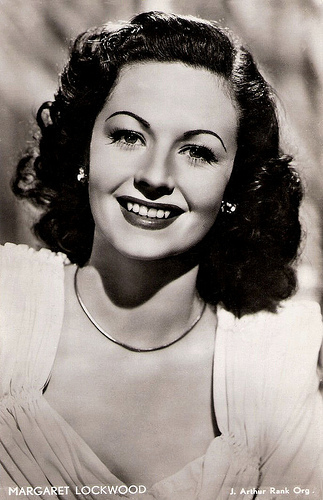
Dutch postcard, no. AX 171. Photo: J. Arthur Rank Org.
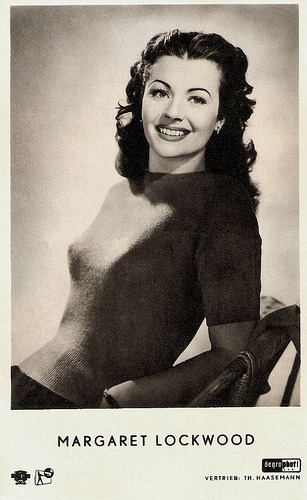
East-German postcard by Th. Haasemann / Degro Phot. Photo: Rank.
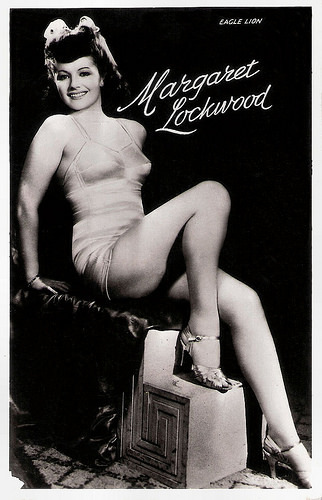
Dutch postcard by Uitgeverij Takken, Utrecht, no. 3239. Photo: Eagle Lion.
Seven Ingenue Screen Roles
Margaret Mary Lockwood Day was born in Karachi, British India (now Karachi, Pakistan), in 1916. She was the daughter of a English administrator of a railway company and his Scottish wife. Lockwood's family returned to the United Kingdom while she was a child, aged 3.
She began studying for the stage at an early age under Italia Conti, and made her debut in 1928, at the age of 12, at the Holborn Empire, where she played a fairy in A Midsummer Night's Dream. In December of the following year, she appeared at the Scala Theatre in the pantomime The Babes in the Wood. In 1932, she appeared at the Theatre Royal, Drury Lane in Cavalcade.
In 1933, she enrolled at the RADA (Royal Academy of Dramatic Art), where she was seen in Leontine Sagan's production of Hannele by a leading London agent, Herbert de Leon, who at once signed her as a client and arranged a screen test. Director Basil Dean was impressed and gave her the second lead in his film Lorna Doone (1934) when Dorothy Hyson fell ill. She was billed with her stage name Margie Day.
Seven ingenue screen roles followed in ‘quota quickies’ like Someday (Michael Powell, 1935) and Midshipman Easy (Carol Reed, 1935). Then she played opposite Maurice Chevalier in the remake of the musical The Beloved Vagabond (1936, Curtis Bernhardt).
A year later, she married Rupert Leon, a man of whom her domineering mother disapproved strongly, so much so that for six months Margaret did not live with her husband and was afraid to tell her mother that the marriage had taken place.
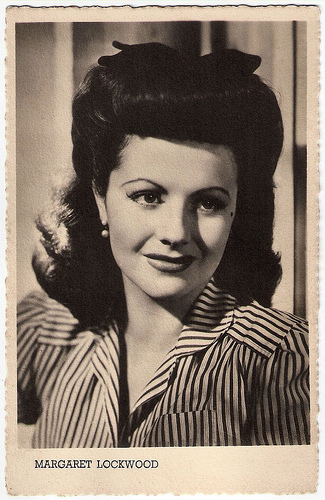
Dutch postcard by S. & v.H.A. Photo: J. Arthur Rank.
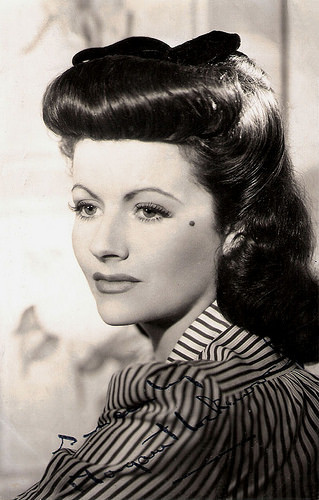
British autograph card, 1947.
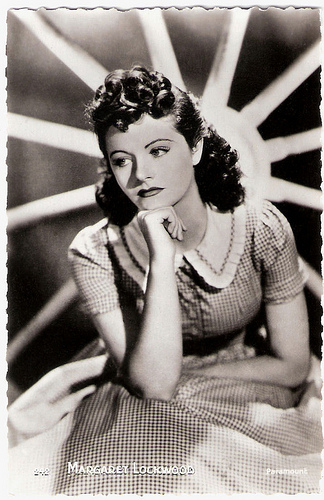
French postcard by Editions P.I., Paris, no. 242. Photo: Paramount.
Rich Young Playgirl
In 1938, Margaret Lockwood's role as a young London nurse in Bank Holiday (Carol Reed, 1938), established her as a star, and her next film would give her even international status.
The Lady Vanishes (Alfred Hitchcock, 1938) offered her a role with teeth. She starred as a rich young playgirl in this glorious comic thriller about a mysteriously disappearing old woman. Her leading man was Michael Redgrave and there was considerable chemistry between the two stars. Hitchcock guides them with never a misstep through a complex script that progresses from very lighthearted to extremely sinister and then back again. The result leaves audiences with both the satisfaction of a well-made thriller and the glow of a romantic comedy. The Gainsborough studio production would be Lockwood’s most successful film of that decade.
A visit to Hollywood to appear with Shirley Temple in Susannah of the Mounties (Walter Lang, William A. Seiter, 1939) and with Douglas Fairbanks Jr. in Rulers of the Sea (Frank Lloyd, 1939) was not at all to her liking.
She returned with relief to Britain to star in two of Carol Reed's best films, The Stars Look Down (1940), as the self-centred, frivolous wife of Michael Redgrave 's character, and the Oscar nominated spy thriller Night Train to Munich (1940), opposite Rex Harrison .
In 1941, she gave birth to a daughter by Leon, Julia Lockwood, affectionately known to her mother as ‘Toots’, who was also to become a successful actress. The Leons separated soon after her birth and were divorced in 1950. Lockwood gained custody of her daughter, but not before Mrs. Lockwood had sided with her son-in-law to allege that Margaret was ‘an unfit mother’.
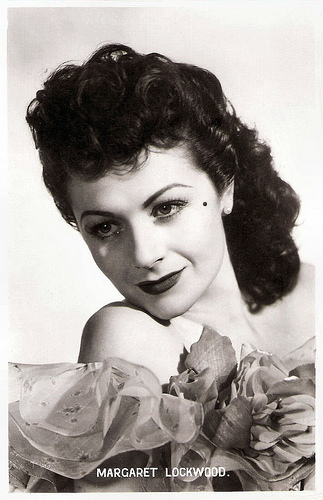
British postcard by Real Photograph, no. F.S. 22. Photo: publicity still for Look Before You Love (Harold Huth, 1948).
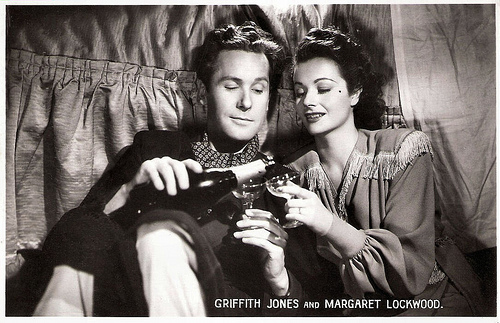
British postcard by Real Photograph, no. F.S. 27. Photo: publicity still for Look Before You Love (Harold Huth, 1948) with Griffith Jones.
Queen Among Villainesses
In the early 1940s, Margaret Lockwood changed her on-screen image. The turning point in her career came in 1943, when she was cast opposite James Mason in the Gainsborough melodrama The Man in Grey (Leslie Arliss, 1943). She played an amoral schemer who steals the husband of her best friend, played by Phyllis Calvert , and then ruthlessly murders her.
Spectral in black, with her dark, dramatic looks, cold but beautiful eyes, and vividly overpainted thin lips, Lockwood was queen among villainesses. The film inaugurated a series of hothouse melodramas that came to be known as Gainsborough Gothic and had film fans queueing outside cinemas all over Britain.
Her greatest success was in the title role of The Wicked Lady (Leslie Arliss, 1945), again opposite Mason. In this outrageous adventure film she played the ultimate in murderous husband-stealers, Lady Skelton, who amuses herself at night with highway robbery.
The amount of cleavage exposed by Lockwood's Restoration gowns caused consternation to the film censors, and apprehension was in the air before the premiere, attended by Queen Mary, who astounded everyone by thoroughly enjoying it. In 1946 Lockwood gained the Daily Mail First Prize for most popular British film actress.
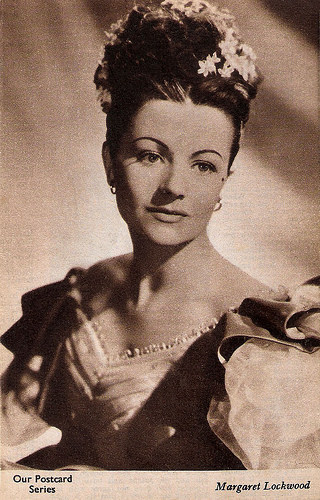
British postcard, 1948.
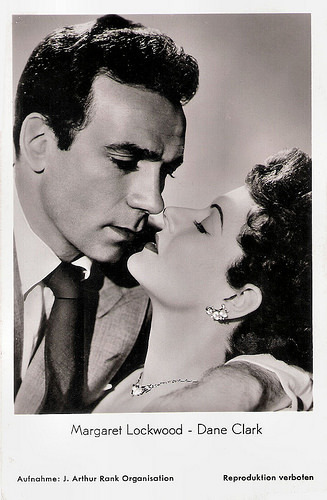
German postcard by F.J. Rüdel Filmpostkartenverlag, Hamburg-Bergedorf, no. 239. Photo: J. Arthur Rank Organisation. Publicity still for Highly Dangerous (Roy Ward Baker, 1950). Highly Dangerous is a British spy film starring Margaret Lockwood as a British entomologist trying to stop a biological attack with the help of an American journalist played by Dane Clark.
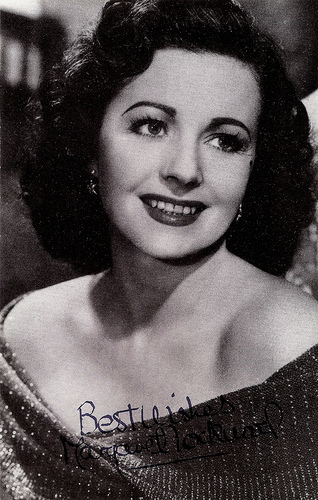
British postcard by Celebrity Publishers LTD., London in the Celebrity Autograph Series, no. 183. Photo: Republic. Publicity still for Trouble in the Glen (Herbert Wilcox, 1954).
Blowsy Ex-barmaid
After poisoning several husbands in Bedelia (Lance Comfort, 1946), Margaret Lockwood became less wicked in Hungry Hill (Brian Desmond Hurst, 1947), Jassy (Bernard Knowles, 1947), and The White Unicorn (Bernard Knowles, 1947, all opposite Dennis Price .
She complained to the head of her studio, J. Arthur Rank, that she was ‘sick of sinning’, but paradoxically, as her roles grew nicer, her popularity declined. Her contract with Rank was dissolved in 1950 and a film deal with Herbert Wilcox, who was married to her principal cinema rival, Anna Neagle , resulted in three disappointing flops.
In 1955, she gave one of her best performances, as a blowsy ex-barmaid in Cast a Dark Shadow (Lewis Gilbert, 1955), opposite Dirk Bogarde , but her box office appeal had waned and she left the screen in favour of the stage. She had success in Peter Pan, Pygmalion, Private Lives, and Agatha Christie's thriller Spider's Web, which ran for over a year. In 1965, she co-starred with her daughter Julia in a popular television series, The Flying Swan.
She lived for many years with actor John Stone, who appeared with her in the 1959 play, And Suddenly It's Spring, and the TV series Justice (Alan Bromly, Brian Farnham, 1971-1974) in which she played a lady barrister. In 1976 she made a long overdue return to films in the Cinderella musical, The Slipper and the Rose (Bryan Forbes, 1976) as the stepmother with the sobriquet, ‘wicked’, omitted but implied.
Her final stage appearance, as Queen Alexandra in Motherdear, ran for only six weeks at the Ambassadors' Theatre in 1980. That year she was created a CBE (Commander of the order of the British Empire). Her investiture at Buckingham Palace was her last public appearance. She was accompanied by her three grandchildren. Margaret Lockwood lived her final decade in seclusion and died in 1990 in Kingston upon Thames, UK, from cirrhosis of the liver, aged 73. Books on Lockwood's career include her own autobiography Lucky Star (1955) and Hilton Tims' Once a Wicked Lady (1989).
Trailer for The Lady Vanishes (1938). Source: Chef du Cinema (YouTube).
Shirley Temple singing One, Two, Three (I'll Teach You to Waltz) in Susannah of the Mounties (1939), also with Randolph Scott. Margaret Lockwood played Vicky Standing. Source: Shirley Temple Fans (YouTube).
Trailer for The Wicked Lady (1945). Source: littleshoemaker (YouTube).
Trailer for The Man in Grey (1943). Source: LittleShoeMaker (YouTube).
Sources: Hal Erickson (AllMovie), Michael Brooke (BFI Screen On Line), Gary F. Taylor (Amazon), Sheridan Morley (The Times), Wikipedia and .

Dutch postcard, no. AX 171. Photo: J. Arthur Rank Org.

East-German postcard by Th. Haasemann / Degro Phot. Photo: Rank.

Dutch postcard by Uitgeverij Takken, Utrecht, no. 3239. Photo: Eagle Lion.
Seven Ingenue Screen Roles
Margaret Mary Lockwood Day was born in Karachi, British India (now Karachi, Pakistan), in 1916. She was the daughter of a English administrator of a railway company and his Scottish wife. Lockwood's family returned to the United Kingdom while she was a child, aged 3.
She began studying for the stage at an early age under Italia Conti, and made her debut in 1928, at the age of 12, at the Holborn Empire, where she played a fairy in A Midsummer Night's Dream. In December of the following year, she appeared at the Scala Theatre in the pantomime The Babes in the Wood. In 1932, she appeared at the Theatre Royal, Drury Lane in Cavalcade.
In 1933, she enrolled at the RADA (Royal Academy of Dramatic Art), where she was seen in Leontine Sagan's production of Hannele by a leading London agent, Herbert de Leon, who at once signed her as a client and arranged a screen test. Director Basil Dean was impressed and gave her the second lead in his film Lorna Doone (1934) when Dorothy Hyson fell ill. She was billed with her stage name Margie Day.
Seven ingenue screen roles followed in ‘quota quickies’ like Someday (Michael Powell, 1935) and Midshipman Easy (Carol Reed, 1935). Then she played opposite Maurice Chevalier in the remake of the musical The Beloved Vagabond (1936, Curtis Bernhardt).
A year later, she married Rupert Leon, a man of whom her domineering mother disapproved strongly, so much so that for six months Margaret did not live with her husband and was afraid to tell her mother that the marriage had taken place.

Dutch postcard by S. & v.H.A. Photo: J. Arthur Rank.

British autograph card, 1947.

French postcard by Editions P.I., Paris, no. 242. Photo: Paramount.
Rich Young Playgirl
In 1938, Margaret Lockwood's role as a young London nurse in Bank Holiday (Carol Reed, 1938), established her as a star, and her next film would give her even international status.
The Lady Vanishes (Alfred Hitchcock, 1938) offered her a role with teeth. She starred as a rich young playgirl in this glorious comic thriller about a mysteriously disappearing old woman. Her leading man was Michael Redgrave and there was considerable chemistry between the two stars. Hitchcock guides them with never a misstep through a complex script that progresses from very lighthearted to extremely sinister and then back again. The result leaves audiences with both the satisfaction of a well-made thriller and the glow of a romantic comedy. The Gainsborough studio production would be Lockwood’s most successful film of that decade.
A visit to Hollywood to appear with Shirley Temple in Susannah of the Mounties (Walter Lang, William A. Seiter, 1939) and with Douglas Fairbanks Jr. in Rulers of the Sea (Frank Lloyd, 1939) was not at all to her liking.
She returned with relief to Britain to star in two of Carol Reed's best films, The Stars Look Down (1940), as the self-centred, frivolous wife of Michael Redgrave 's character, and the Oscar nominated spy thriller Night Train to Munich (1940), opposite Rex Harrison .
In 1941, she gave birth to a daughter by Leon, Julia Lockwood, affectionately known to her mother as ‘Toots’, who was also to become a successful actress. The Leons separated soon after her birth and were divorced in 1950. Lockwood gained custody of her daughter, but not before Mrs. Lockwood had sided with her son-in-law to allege that Margaret was ‘an unfit mother’.

British postcard by Real Photograph, no. F.S. 22. Photo: publicity still for Look Before You Love (Harold Huth, 1948).

British postcard by Real Photograph, no. F.S. 27. Photo: publicity still for Look Before You Love (Harold Huth, 1948) with Griffith Jones.
Queen Among Villainesses
In the early 1940s, Margaret Lockwood changed her on-screen image. The turning point in her career came in 1943, when she was cast opposite James Mason in the Gainsborough melodrama The Man in Grey (Leslie Arliss, 1943). She played an amoral schemer who steals the husband of her best friend, played by Phyllis Calvert , and then ruthlessly murders her.
Spectral in black, with her dark, dramatic looks, cold but beautiful eyes, and vividly overpainted thin lips, Lockwood was queen among villainesses. The film inaugurated a series of hothouse melodramas that came to be known as Gainsborough Gothic and had film fans queueing outside cinemas all over Britain.
Her greatest success was in the title role of The Wicked Lady (Leslie Arliss, 1945), again opposite Mason. In this outrageous adventure film she played the ultimate in murderous husband-stealers, Lady Skelton, who amuses herself at night with highway robbery.
The amount of cleavage exposed by Lockwood's Restoration gowns caused consternation to the film censors, and apprehension was in the air before the premiere, attended by Queen Mary, who astounded everyone by thoroughly enjoying it. In 1946 Lockwood gained the Daily Mail First Prize for most popular British film actress.

British postcard, 1948.

German postcard by F.J. Rüdel Filmpostkartenverlag, Hamburg-Bergedorf, no. 239. Photo: J. Arthur Rank Organisation. Publicity still for Highly Dangerous (Roy Ward Baker, 1950). Highly Dangerous is a British spy film starring Margaret Lockwood as a British entomologist trying to stop a biological attack with the help of an American journalist played by Dane Clark.

British postcard by Celebrity Publishers LTD., London in the Celebrity Autograph Series, no. 183. Photo: Republic. Publicity still for Trouble in the Glen (Herbert Wilcox, 1954).
Blowsy Ex-barmaid
After poisoning several husbands in Bedelia (Lance Comfort, 1946), Margaret Lockwood became less wicked in Hungry Hill (Brian Desmond Hurst, 1947), Jassy (Bernard Knowles, 1947), and The White Unicorn (Bernard Knowles, 1947, all opposite Dennis Price .
She complained to the head of her studio, J. Arthur Rank, that she was ‘sick of sinning’, but paradoxically, as her roles grew nicer, her popularity declined. Her contract with Rank was dissolved in 1950 and a film deal with Herbert Wilcox, who was married to her principal cinema rival, Anna Neagle , resulted in three disappointing flops.
In 1955, she gave one of her best performances, as a blowsy ex-barmaid in Cast a Dark Shadow (Lewis Gilbert, 1955), opposite Dirk Bogarde , but her box office appeal had waned and she left the screen in favour of the stage. She had success in Peter Pan, Pygmalion, Private Lives, and Agatha Christie's thriller Spider's Web, which ran for over a year. In 1965, she co-starred with her daughter Julia in a popular television series, The Flying Swan.
She lived for many years with actor John Stone, who appeared with her in the 1959 play, And Suddenly It's Spring, and the TV series Justice (Alan Bromly, Brian Farnham, 1971-1974) in which she played a lady barrister. In 1976 she made a long overdue return to films in the Cinderella musical, The Slipper and the Rose (Bryan Forbes, 1976) as the stepmother with the sobriquet, ‘wicked’, omitted but implied.
Her final stage appearance, as Queen Alexandra in Motherdear, ran for only six weeks at the Ambassadors' Theatre in 1980. That year she was created a CBE (Commander of the order of the British Empire). Her investiture at Buckingham Palace was her last public appearance. She was accompanied by her three grandchildren. Margaret Lockwood lived her final decade in seclusion and died in 1990 in Kingston upon Thames, UK, from cirrhosis of the liver, aged 73. Books on Lockwood's career include her own autobiography Lucky Star (1955) and Hilton Tims' Once a Wicked Lady (1989).
Trailer for The Lady Vanishes (1938). Source: Chef du Cinema (YouTube).
Shirley Temple singing One, Two, Three (I'll Teach You to Waltz) in Susannah of the Mounties (1939), also with Randolph Scott. Margaret Lockwood played Vicky Standing. Source: Shirley Temple Fans (YouTube).
Trailer for The Wicked Lady (1945). Source: littleshoemaker (YouTube).
Trailer for The Man in Grey (1943). Source: LittleShoeMaker (YouTube).
Sources: Hal Erickson (AllMovie), Michael Brooke (BFI Screen On Line), Gary F. Taylor (Amazon), Sheridan Morley (The Times), Wikipedia and .
Published on February 29, 2016 22:00
February 28, 2016
Stefan Lisewski (1933-2016)
On Friday, 26 February 2016, German actor Stefan Lisewski has passed away in his howetown Berlin. He was well known as an interpreter of the plays of Bertolt Brecht and as one the stars of the Krimi series Polizeiruf 110. He also apperared in several East-German films. He was 82.
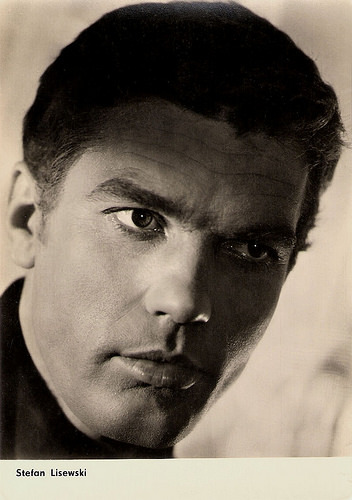
East-German postcard by VEB Progress Filmvertrieb, Berlin, no. 1661. Photo: DEFA / Pathenheimer.
Trouble with official socialist morality
Stefan Lisewski was born in 1933 in Tczew, Poland. After the end of World War II, Lisewski aimed initially at a career as a metallurgical engineer and studied at the Bergakademie in Freiberg. But his passion was the theatre and he played various roles as an extra in stage productions.
When he attempted for the second time to study acting at the State Drama School in Berlin, he was admitted. After finishing his studies, Lisewski gained 1957 a long-standing commitment at the Berliner Ensemble, where he worked until 1999. For decades he was one of their main pillars and played leading roles in almost all of Brecht's plays, including the part of Mack the Knife in The Threepenny Opera.
In addition to his stage work Lisewski gained great popularity through roles in DEFA features and films for the television of the GDR. His screen debut in Das Lied der Matrosen/The song of the sailors (Kurt Maetzig, Günter Reisch, 1958), was also his breakthrough.
The romantic comedy Verwirrung der Liebe/Confusion of love (Slatan Dudow, 1959) made him a crowd favourite. This big-budget production featuring Angelica Domröse , Annekatrin Bürger and Willi Schrade, ran into trouble with official socialist morality due to its frank depiction of sex (including nude bathing scenes) and portrayal of consumerism, along with a very stylized version of comedy.
Countless roles followed in such films as Die Jagd nach dem Stiefel/The hunt for the boots (Konrad Petzold, 1962), Solange Leben in mir ist/As long as life is in me (Günter Reisch, 1965), the biography of the socialistic politician Karl Liebknecht, and the Western Tödlicher Irrtum/Fatal Error (Konrad Petzold, 1970) with Armin Mueller-Stahl and Gojko Mitic .
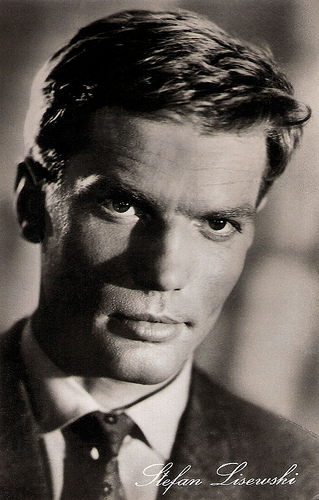
East-German postcard by VEB Progress Filmvertrieb, Berlin, no. 1298, 1960. Photo: DEFA / Neufeld.
Playing God
In the 1970s, Stefan Lisewski concentrated increasingly on his stage career. He played supporting parts in films like Susanne und der Zauberring/Susanne and the magic ring (Erwin Stranka, 1974), Die Leiden des jungen Werthers/The Sorrows of Young Werther (Egon Günther, 1976), and Beethoven - Tage aus einem Leben/Beethoven-Days in a Life (Horst Seemann, 1976) with Donatas Banionis .
In 1977 he was awarded the Art Prize of the GDR. On TV, he played roles in the children's series Spuk unterm Riesenrad/Spook under the Ferris Wheel (Günter Meyer, 1979) and Spuk im Hochhaus/Spook in the skyscraper (Günter Meyer, 1982-1983). Furthermore, he became known as an actor in radio plays.
His later film roles include God in Gottes Besuch/God's visit (Damir Lukacevic, 1998) and a scientist in the SF-film Transfer (Damir Lukacevic, 2010), his final film role. In 2002 he played the ogre in the opera Pollicino by Hans Werner Henze, directed by Jobst Liebrecht. The CD recording won a 2004 Echo. Until recently, he played the role of Dogsborough in Brecht's Der aufhaltsame Aufstieg des Arturo Ui/The resistible rise of Arturo Ui, directed by Heiner Müller. It was performed more than 300 times at home and abroad.
Stefan Lisewski was briefly married with fellow actress Monika Gabriel. In 1969 he married his second wife Karin, with whom he lived in Berlin. From this relationship, two sons were born.
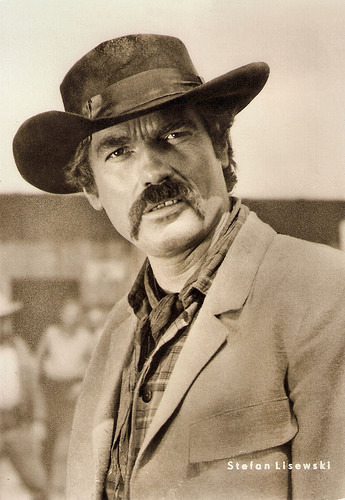
East-German postcard by VEB Progress Filmvertrieb, Berlin, no. 123/70. Photo: DEFA / Blümel. Publicity still for Tödlicher Irrtum/Fatal Error (1970).
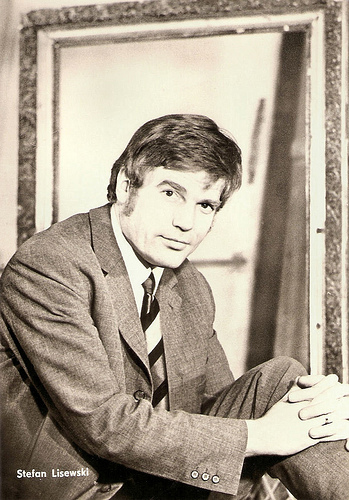
East-German postcard by VEB Progress Filmvertrieb, Berlin, no. 62 / 70. Photo: Linke.
Source: Wikipedia (German) and .

East-German postcard by VEB Progress Filmvertrieb, Berlin, no. 1661. Photo: DEFA / Pathenheimer.
Trouble with official socialist morality
Stefan Lisewski was born in 1933 in Tczew, Poland. After the end of World War II, Lisewski aimed initially at a career as a metallurgical engineer and studied at the Bergakademie in Freiberg. But his passion was the theatre and he played various roles as an extra in stage productions.
When he attempted for the second time to study acting at the State Drama School in Berlin, he was admitted. After finishing his studies, Lisewski gained 1957 a long-standing commitment at the Berliner Ensemble, where he worked until 1999. For decades he was one of their main pillars and played leading roles in almost all of Brecht's plays, including the part of Mack the Knife in The Threepenny Opera.
In addition to his stage work Lisewski gained great popularity through roles in DEFA features and films for the television of the GDR. His screen debut in Das Lied der Matrosen/The song of the sailors (Kurt Maetzig, Günter Reisch, 1958), was also his breakthrough.
The romantic comedy Verwirrung der Liebe/Confusion of love (Slatan Dudow, 1959) made him a crowd favourite. This big-budget production featuring Angelica Domröse , Annekatrin Bürger and Willi Schrade, ran into trouble with official socialist morality due to its frank depiction of sex (including nude bathing scenes) and portrayal of consumerism, along with a very stylized version of comedy.
Countless roles followed in such films as Die Jagd nach dem Stiefel/The hunt for the boots (Konrad Petzold, 1962), Solange Leben in mir ist/As long as life is in me (Günter Reisch, 1965), the biography of the socialistic politician Karl Liebknecht, and the Western Tödlicher Irrtum/Fatal Error (Konrad Petzold, 1970) with Armin Mueller-Stahl and Gojko Mitic .

East-German postcard by VEB Progress Filmvertrieb, Berlin, no. 1298, 1960. Photo: DEFA / Neufeld.
Playing God
In the 1970s, Stefan Lisewski concentrated increasingly on his stage career. He played supporting parts in films like Susanne und der Zauberring/Susanne and the magic ring (Erwin Stranka, 1974), Die Leiden des jungen Werthers/The Sorrows of Young Werther (Egon Günther, 1976), and Beethoven - Tage aus einem Leben/Beethoven-Days in a Life (Horst Seemann, 1976) with Donatas Banionis .
In 1977 he was awarded the Art Prize of the GDR. On TV, he played roles in the children's series Spuk unterm Riesenrad/Spook under the Ferris Wheel (Günter Meyer, 1979) and Spuk im Hochhaus/Spook in the skyscraper (Günter Meyer, 1982-1983). Furthermore, he became known as an actor in radio plays.
His later film roles include God in Gottes Besuch/God's visit (Damir Lukacevic, 1998) and a scientist in the SF-film Transfer (Damir Lukacevic, 2010), his final film role. In 2002 he played the ogre in the opera Pollicino by Hans Werner Henze, directed by Jobst Liebrecht. The CD recording won a 2004 Echo. Until recently, he played the role of Dogsborough in Brecht's Der aufhaltsame Aufstieg des Arturo Ui/The resistible rise of Arturo Ui, directed by Heiner Müller. It was performed more than 300 times at home and abroad.
Stefan Lisewski was briefly married with fellow actress Monika Gabriel. In 1969 he married his second wife Karin, with whom he lived in Berlin. From this relationship, two sons were born.

East-German postcard by VEB Progress Filmvertrieb, Berlin, no. 123/70. Photo: DEFA / Blümel. Publicity still for Tödlicher Irrtum/Fatal Error (1970).

East-German postcard by VEB Progress Filmvertrieb, Berlin, no. 62 / 70. Photo: Linke.
Source: Wikipedia (German) and .
Published on February 28, 2016 22:00
February 27, 2016
Anthony Bushell
English film actor and director Anthony Bushell (1904-1997) appeared in 56 films between 1929 and 1961. Bushell was a cultured performer with a penchant for playing military men, such as in James Whale’s Journey's End (1930). He also appeared in and directed various British TV series like Danger Man (1961).
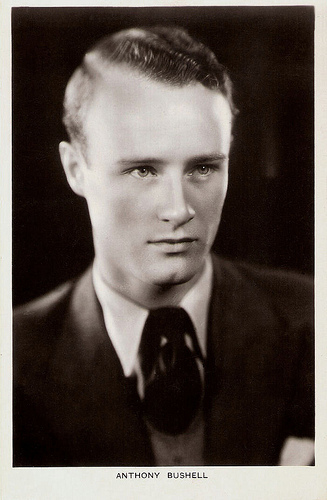
British postcard in the Picturegoer Series, London, no. 485.
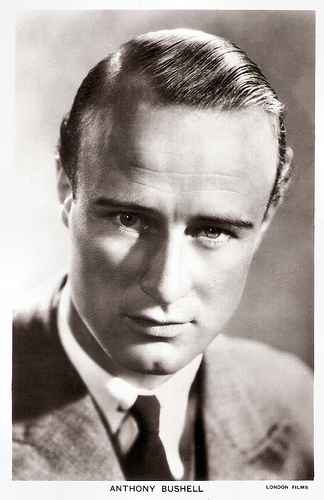
British postcard in the Picturegoer Series, London, no. 485a, Photo: London Films.
Journey's End
Anthony Arnatt Bushell was born in Westerham, Kent, in 1904 and he was educated at Magdalen College School, and then Hertford College, Oxford. After Oxford, he trained at the Royal Academy of Dramatic Art and got his start on stage from Sir Gerald du Maurier, making his theatrical debut in Victorien Sardou's Diplomacy at the Adelphi Theatre in 1924.
Bushell worked in the U.S. for a time in 1927-1928, touring in Her Cardboard Lover with Jeanne Eagels. In 1928 he met American actress Zelma O'Neal, who was performing on the London stage in the musical Good News. They married in New York in 1928, when he was appearing on Broadway in W. Somerset Maugham's The Sacred Flame and she was preparing to open in the musical Follow Thru.
George Arliss saw Bushell on Broadway and when he was cast as the lead in his first talkie, Disraeli (Alfred E. Green, 1929), an American biopic of the famed British Prime Minister, he recommended Bushell for the role of Disraeli's young rival Charles Deeford.
Bushell was cast in another American film Jealousy (1929), but after shooting was completed all his scenes were re-shot with Frederic March at the insistence of his co-star Jeanne Eagels.
He appeared in the first American-British co-production of the sound era, the war drama Journey's End (James Whale, 1930) with Colin Clive . His other Hollywood films, also often saw him in the military roles that became his speciality.
These films included Three Faces East (Roy Del Ruth, 1930) with Erich Von Stroheim , Five Star Final (Mervyn LeRoy, 1931) with Edward G. Robinson, Chances (Allan Dwan, 1931) with Douglas Fairbanks Jr., Vanity Fair (Chester M. Franklin, 1932) with Myrna Loy, and A Woman Commands (Paul L. Stein, 1932) with Pola Negri in her first sound picture.
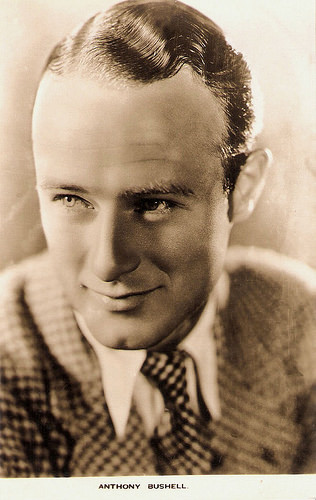
British postcard in the Film Weekly Series, London.
In the armed forces
In 1930, Anthony Bushell and his wife took a delayed honeymoon trip to Germany, France, and England. They relocated to London in 1932, where she established a second stage career. They divorced in 1935. Following their divorce, they appeared in the same show at least once, though they did not appear together on stage. O'Neal returned to New York in June 1937.
Bushell remained in England and played more important roles in several films: The Midshipmaid (Albert de Courville, 1932) with Jessie Matthews; Boris Karloff's horror film The Ghoul (T. Hayes Hunter, 1933) where he played the romantic lead; The Scarlet Pimpernel (Harold Young, 1934) with Leslie Howard , and Dark Journey (Victor Saville, 1937) with Conrad Veidt and Vivien Leigh .
He had a brief affair with Patricia Roc , with whom he appeared and gave her first onscreen kiss in film The Rebel Son (Adrian Brunel, Albert de Courville, Alexis Granowsky, 1938) set in 17th-century Ukraine. Wikipedia quotes Graham Greene, who wrote in The Spectator a sarcastic assessment of the film, which he left a half hour: "I liked particularly the scene when the young Cossack (played by Mr. Anthony Bushell with his keen young Oxford accent) bursts into the bedroom of the girl he loves, 'I know it's very late to call but ... O I am glad you are not angry.'"
In Arsenal Stadium Mystery (Thorold Dickinson, 1939) the Arsenal football team appeared and Bushnell played their star football player who is poisoned during a match. In The Lion Has Wings (Adrian Brunel, Brian Desmond Hurst, Michael Powell, 1939), a documentary-style anti-German propaganda film, he was cast, in one critic's words, as one of several "idiosyncratic but not over well-known actors" who could stand in for RAF crew members.
In 1939, he joined the British Armed Forces, was commissioned in the Welsh Guards and served in the Guards Armoured Division as a tank squadron commander. During the war he married his second wife, Anne.
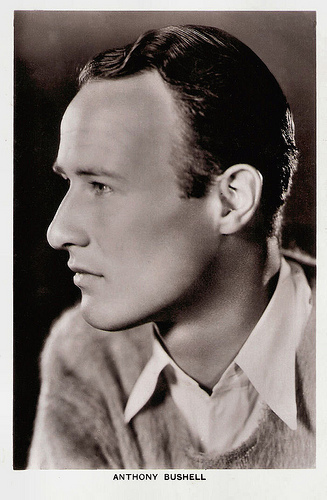
British postcard in the Picturegoer Series, London, no. 485 a.
The Angel with the Trumpet
After the war, Anthony Bushell developed a relationship with Laurence Olivier , at whose urging he served as associate producer on Olivier's Shakespearean production Hamlet (1948) and later as associate director on Richard III (1965) and The Prince and the Showgirl (1957), helping with Olivier's scenes in these films.
He directed for the first time in 1950, using material from an earlier Austrian filmed called Der Engel mit der Posaune (Karl Hartl, 1950), with Maria Schell . He substituted new scenes with British actors where necessary and dubbed minor roles to create an English-language version, The Angel with the Trumpet (1951). Bushell also took the role of Baron Traun, companion to Rudolf, Crown Prince of Austria.
Of his direction in partnership with Reginald Beck of The Long Dark Hall (1951), Wikipedia quotes a critic: "The tandem direction is surprisingly able and occasionally inventive." However, Hal Erickson at AllMovie writes that his three films (the third was The Terror of the Tongs (1961)) were “profitable if undistinguished”.
During the 1950s, Bushell also played King Arthur in The Black Knight (Tay Garnett, 1954), and the captain of the Carpathia in an early version of the Titanic disaster, A Night to Remember (Roy Ward Baker, 1958).
In the early 1960s, he directed segments of The Valiant Years, a documentary based on the memoirs of Winston Churchill. Though it was a documentary, and BBC rules forbade the use of re-enactments, Bushell appeared in one scene as an RAF air marshal deriding British attempts to sway German public opinion by dropping leaflets on their cities early in World War II. He was filling in for Sir Arthur ‘Bomber’ Harris and speaking Harris' words only because illness prevented Harris from participating on the day scheduled for filming.
He retired in 1964, and he later served as director of the Monte Carlo Golf Club. Anthony Bushell died in Oxford in 1997. He was 92.
DVD Trailer for The Angel with the Trumpet (Anthony Bushell, 1951). Source: Network Distributing (YouTube).
Trailer The Terror of the Tongs (Anthony Bushell, 1961). Source: cushing97380 (YouTube).
Sources: Hal Erickson (AllMovie), Wikipedia and .

British postcard in the Picturegoer Series, London, no. 485.

British postcard in the Picturegoer Series, London, no. 485a, Photo: London Films.
Journey's End
Anthony Arnatt Bushell was born in Westerham, Kent, in 1904 and he was educated at Magdalen College School, and then Hertford College, Oxford. After Oxford, he trained at the Royal Academy of Dramatic Art and got his start on stage from Sir Gerald du Maurier, making his theatrical debut in Victorien Sardou's Diplomacy at the Adelphi Theatre in 1924.
Bushell worked in the U.S. for a time in 1927-1928, touring in Her Cardboard Lover with Jeanne Eagels. In 1928 he met American actress Zelma O'Neal, who was performing on the London stage in the musical Good News. They married in New York in 1928, when he was appearing on Broadway in W. Somerset Maugham's The Sacred Flame and she was preparing to open in the musical Follow Thru.
George Arliss saw Bushell on Broadway and when he was cast as the lead in his first talkie, Disraeli (Alfred E. Green, 1929), an American biopic of the famed British Prime Minister, he recommended Bushell for the role of Disraeli's young rival Charles Deeford.
Bushell was cast in another American film Jealousy (1929), but after shooting was completed all his scenes were re-shot with Frederic March at the insistence of his co-star Jeanne Eagels.
He appeared in the first American-British co-production of the sound era, the war drama Journey's End (James Whale, 1930) with Colin Clive . His other Hollywood films, also often saw him in the military roles that became his speciality.
These films included Three Faces East (Roy Del Ruth, 1930) with Erich Von Stroheim , Five Star Final (Mervyn LeRoy, 1931) with Edward G. Robinson, Chances (Allan Dwan, 1931) with Douglas Fairbanks Jr., Vanity Fair (Chester M. Franklin, 1932) with Myrna Loy, and A Woman Commands (Paul L. Stein, 1932) with Pola Negri in her first sound picture.

British postcard in the Film Weekly Series, London.
In the armed forces
In 1930, Anthony Bushell and his wife took a delayed honeymoon trip to Germany, France, and England. They relocated to London in 1932, where she established a second stage career. They divorced in 1935. Following their divorce, they appeared in the same show at least once, though they did not appear together on stage. O'Neal returned to New York in June 1937.
Bushell remained in England and played more important roles in several films: The Midshipmaid (Albert de Courville, 1932) with Jessie Matthews; Boris Karloff's horror film The Ghoul (T. Hayes Hunter, 1933) where he played the romantic lead; The Scarlet Pimpernel (Harold Young, 1934) with Leslie Howard , and Dark Journey (Victor Saville, 1937) with Conrad Veidt and Vivien Leigh .
He had a brief affair with Patricia Roc , with whom he appeared and gave her first onscreen kiss in film The Rebel Son (Adrian Brunel, Albert de Courville, Alexis Granowsky, 1938) set in 17th-century Ukraine. Wikipedia quotes Graham Greene, who wrote in The Spectator a sarcastic assessment of the film, which he left a half hour: "I liked particularly the scene when the young Cossack (played by Mr. Anthony Bushell with his keen young Oxford accent) bursts into the bedroom of the girl he loves, 'I know it's very late to call but ... O I am glad you are not angry.'"
In Arsenal Stadium Mystery (Thorold Dickinson, 1939) the Arsenal football team appeared and Bushnell played their star football player who is poisoned during a match. In The Lion Has Wings (Adrian Brunel, Brian Desmond Hurst, Michael Powell, 1939), a documentary-style anti-German propaganda film, he was cast, in one critic's words, as one of several "idiosyncratic but not over well-known actors" who could stand in for RAF crew members.
In 1939, he joined the British Armed Forces, was commissioned in the Welsh Guards and served in the Guards Armoured Division as a tank squadron commander. During the war he married his second wife, Anne.

British postcard in the Picturegoer Series, London, no. 485 a.
The Angel with the Trumpet
After the war, Anthony Bushell developed a relationship with Laurence Olivier , at whose urging he served as associate producer on Olivier's Shakespearean production Hamlet (1948) and later as associate director on Richard III (1965) and The Prince and the Showgirl (1957), helping with Olivier's scenes in these films.
He directed for the first time in 1950, using material from an earlier Austrian filmed called Der Engel mit der Posaune (Karl Hartl, 1950), with Maria Schell . He substituted new scenes with British actors where necessary and dubbed minor roles to create an English-language version, The Angel with the Trumpet (1951). Bushell also took the role of Baron Traun, companion to Rudolf, Crown Prince of Austria.
Of his direction in partnership with Reginald Beck of The Long Dark Hall (1951), Wikipedia quotes a critic: "The tandem direction is surprisingly able and occasionally inventive." However, Hal Erickson at AllMovie writes that his three films (the third was The Terror of the Tongs (1961)) were “profitable if undistinguished”.
During the 1950s, Bushell also played King Arthur in The Black Knight (Tay Garnett, 1954), and the captain of the Carpathia in an early version of the Titanic disaster, A Night to Remember (Roy Ward Baker, 1958).
In the early 1960s, he directed segments of The Valiant Years, a documentary based on the memoirs of Winston Churchill. Though it was a documentary, and BBC rules forbade the use of re-enactments, Bushell appeared in one scene as an RAF air marshal deriding British attempts to sway German public opinion by dropping leaflets on their cities early in World War II. He was filling in for Sir Arthur ‘Bomber’ Harris and speaking Harris' words only because illness prevented Harris from participating on the day scheduled for filming.
He retired in 1964, and he later served as director of the Monte Carlo Golf Club. Anthony Bushell died in Oxford in 1997. He was 92.
DVD Trailer for The Angel with the Trumpet (Anthony Bushell, 1951). Source: Network Distributing (YouTube).
Trailer The Terror of the Tongs (Anthony Bushell, 1961). Source: cushing97380 (YouTube).
Sources: Hal Erickson (AllMovie), Wikipedia and .
Published on February 27, 2016 22:00
February 26, 2016
André Dassary
Handsome French singer André Dassary (1912-1987) was a star of the French operetta and made several popular records. The ‘tenor with the golden voice’ also performed in some films.
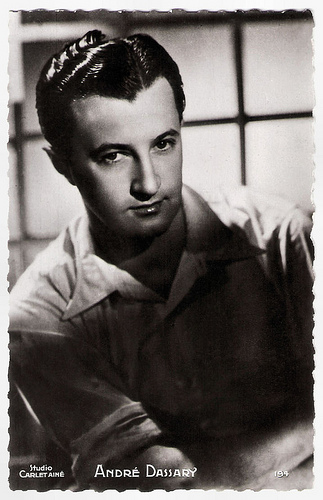
French postcard by Editions P.I., Paris, no. 194. Photo: Studio Carlet Ainé.
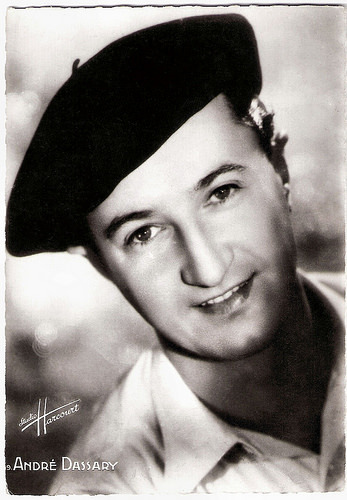
French postcard by Greff, Paris, no. 9. Photo: Studio Harcourt.
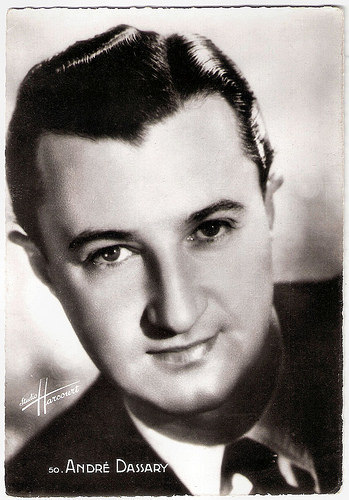
French postcard by Greff, Paris, no. 50. Photo: Studio Harcourt.
Notoriety under the Occupation
André Dassary was born as André Deyhérassary in Biarritz, France, in 1912. After his secondary education at St. Genesius school in Bordeaux, he developed a passion for sport and became a professional masseur. In this capacity, he accompanied the French team at the student Olympics of 1937.
He studied at the Bordeaux Conservatory where he won the first prize for singing, operetta and comic opera. Still a student, he made his radio debut in 1938.
He was spotted by Fred Pasquali who offered him a part in the operetta Le Roi du cirque (King of the circus, 1938), composed by Kalman. Dassary refused, but still Pasquali introduced him to orchestra leader Ray Ventura.
There he started his career and also made his film debut with Ventura. In the Ventura musical Tourbillon de Paris/Whirlwind of Paris (Henri Diamant-Berger, 1939), he played a student. In 1943, he also performed in the Ventura musical, Feux de joie/Bonfires (Jacques Houssin, 1943), with René Lefèvre .
With the orchestras of Ventura, Marcel Cariven and Wal-Berg, he made several popular records during the 1930s and 1940s.
Dassary was a captive in Germany at the start of World War II. He was released and achieved notoriety under the Occupation, especially for a song to the glory of Marshal Pétain, Maréchal, nous voilà! (Marshal we come!). This song became emblematic for the Vichy regime.
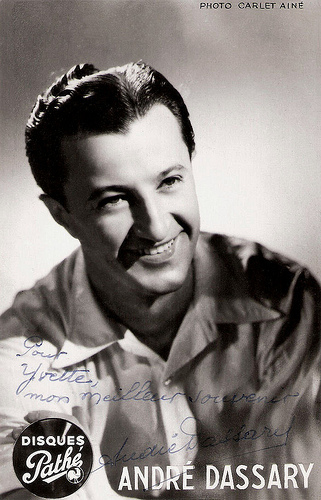
French postcard by Disques Pathé. Photo: Roger Carlet ainé.
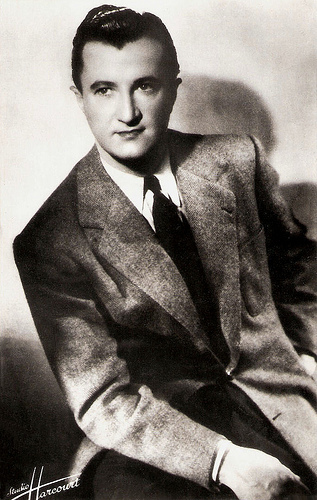
French postcard by Editions O.P., Paris, no. 41. Photo: Studio Harcourt.
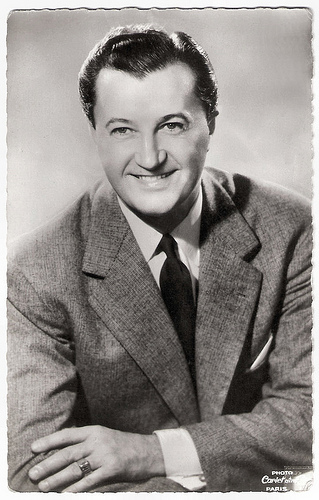
French postcard by Editions du Globe, Paris, no. 257. Photo: Roger Carlet ainé, Paris.
Ramuntcho
After the war, André Dassary was criticized for his behaviour during the occupation, although his popularity had not waned.
Among his successes is especially notable Ramuntcho (1944), a song by Vincent Scotto and John Rodor.
Dassary would also star in a film around the song, Le mariage de Ramuntcho/The Marriage of Ramuntcho (Max de Vaucorbeil, 1947), with Gaby Sylvia . It was also notable because it was the first French film in colour. He then appeared in the musical Paris chante toujours!/Paris Still Sings! (Pierre Montazel, 1951).
In 1946, the handsome, athletic Dassary directed his career towards the operetta and appeared in an almost tailor-made role as the lead in L'ingénue de Londres (The young lover in London). Then he performed in his finest creation, Chanson Gitane (Gypsy Song), which was performed over a thousand times, in France and abroad.
He also starred in the operetta La Toison d'or (The Golden Fleece, 1954) by Francis Lopez and Raymond Vincy at the Théâtre du Châtelet. Many operettas and other performances followed. Later, he recorded Basque folklore inspired songs with Raymond Legrand's Orchestra, the father of Michel Legrand.
André Dassary continued performing till he retired in 1970. Dassary died in Paris in 1987. He is the father of the actress Evelyn Dandry.
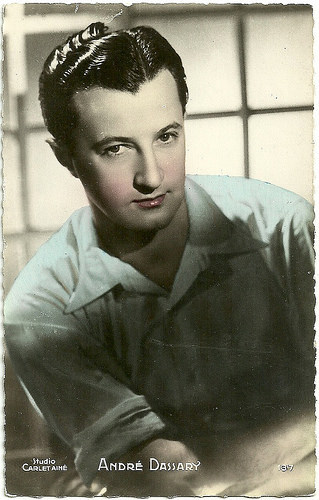
French postcard by Editions P.I., Paris, no. 137. Photo: Studio Carlet Ainé.
André Dassary sings Ramuntcho (1945). Source: Vieux Disques (YouTube).
André Dassary sings La petite église in 1966, accompanied by the orchestra of Raymond Lefevre. Source: Ina Chansons (YouTube).
Sources: Du temps des cerises aux feuilles mortes (French), Wikipedia (French) and .

French postcard by Editions P.I., Paris, no. 194. Photo: Studio Carlet Ainé.

French postcard by Greff, Paris, no. 9. Photo: Studio Harcourt.

French postcard by Greff, Paris, no. 50. Photo: Studio Harcourt.
Notoriety under the Occupation
André Dassary was born as André Deyhérassary in Biarritz, France, in 1912. After his secondary education at St. Genesius school in Bordeaux, he developed a passion for sport and became a professional masseur. In this capacity, he accompanied the French team at the student Olympics of 1937.
He studied at the Bordeaux Conservatory where he won the first prize for singing, operetta and comic opera. Still a student, he made his radio debut in 1938.
He was spotted by Fred Pasquali who offered him a part in the operetta Le Roi du cirque (King of the circus, 1938), composed by Kalman. Dassary refused, but still Pasquali introduced him to orchestra leader Ray Ventura.
There he started his career and also made his film debut with Ventura. In the Ventura musical Tourbillon de Paris/Whirlwind of Paris (Henri Diamant-Berger, 1939), he played a student. In 1943, he also performed in the Ventura musical, Feux de joie/Bonfires (Jacques Houssin, 1943), with René Lefèvre .
With the orchestras of Ventura, Marcel Cariven and Wal-Berg, he made several popular records during the 1930s and 1940s.
Dassary was a captive in Germany at the start of World War II. He was released and achieved notoriety under the Occupation, especially for a song to the glory of Marshal Pétain, Maréchal, nous voilà! (Marshal we come!). This song became emblematic for the Vichy regime.

French postcard by Disques Pathé. Photo: Roger Carlet ainé.

French postcard by Editions O.P., Paris, no. 41. Photo: Studio Harcourt.

French postcard by Editions du Globe, Paris, no. 257. Photo: Roger Carlet ainé, Paris.
Ramuntcho
After the war, André Dassary was criticized for his behaviour during the occupation, although his popularity had not waned.
Among his successes is especially notable Ramuntcho (1944), a song by Vincent Scotto and John Rodor.
Dassary would also star in a film around the song, Le mariage de Ramuntcho/The Marriage of Ramuntcho (Max de Vaucorbeil, 1947), with Gaby Sylvia . It was also notable because it was the first French film in colour. He then appeared in the musical Paris chante toujours!/Paris Still Sings! (Pierre Montazel, 1951).
In 1946, the handsome, athletic Dassary directed his career towards the operetta and appeared in an almost tailor-made role as the lead in L'ingénue de Londres (The young lover in London). Then he performed in his finest creation, Chanson Gitane (Gypsy Song), which was performed over a thousand times, in France and abroad.
He also starred in the operetta La Toison d'or (The Golden Fleece, 1954) by Francis Lopez and Raymond Vincy at the Théâtre du Châtelet. Many operettas and other performances followed. Later, he recorded Basque folklore inspired songs with Raymond Legrand's Orchestra, the father of Michel Legrand.
André Dassary continued performing till he retired in 1970. Dassary died in Paris in 1987. He is the father of the actress Evelyn Dandry.

French postcard by Editions P.I., Paris, no. 137. Photo: Studio Carlet Ainé.
André Dassary sings Ramuntcho (1945). Source: Vieux Disques (YouTube).
André Dassary sings La petite église in 1966, accompanied by the orchestra of Raymond Lefevre. Source: Ina Chansons (YouTube).
Sources: Du temps des cerises aux feuilles mortes (French), Wikipedia (French) and .
Published on February 26, 2016 22:00
February 25, 2016
EFSP's Dazzling Dozen: Kissing Willy Fritsch
Willy Fritsch (1901-1973) was the darling of the female filmgoers of the 1930s and 1940s. He was the immensely popular ‘Sunny Boy’ of the Ufa operettas and a real heartthrob for our grannies. With Lilian Harvey, he formed the 'Traumpaar' (Dream couple) of the German cinema, but Fritsch kissed also many other girls onscreen. And Willy formed a perfect pair with his Austrian (and gay) co-star Willi Forst.
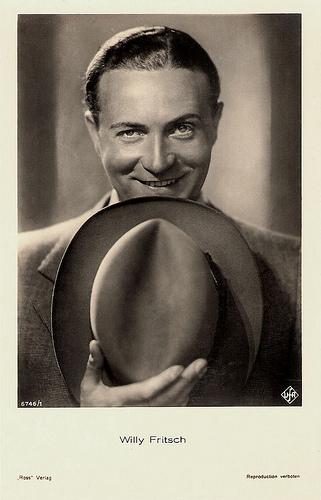
Willy Fritsch . German postcard by Ross Verlag, no. 6746/1, 1931-1932. Photo: Ufa.
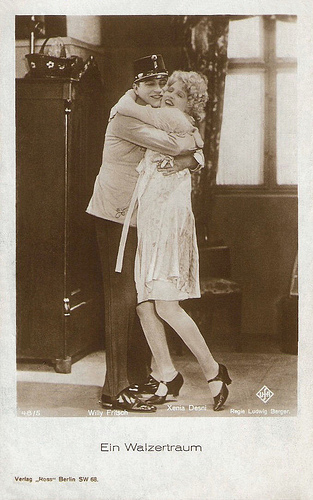
German postcard by Ross Verlag, no. 48/5, 1925-1926. Photo: Ufa. Publicity still for Ein Walzertraum/The Waltz Dream (Ludwig Berger, 1925) with Xenia Desni and Willy Fritsch .
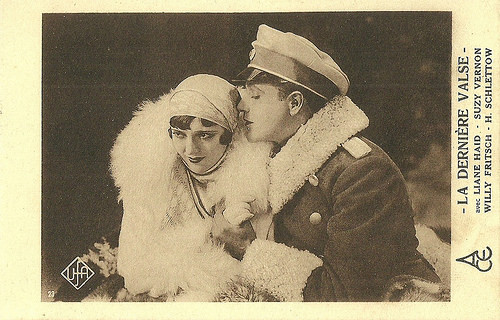
French postcard by ACE. Photo: Ufa. Suzy Vernon and Willy Fritsch in the German operetta film Der letzte Walzer/The Last Waltz (Arthur Robison, 1927).
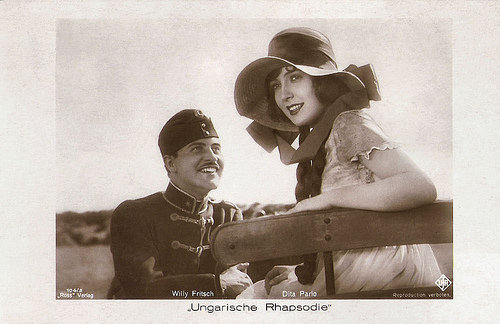
German postcard by Ross Verlag, no. 104/3, 1925-1935. Photo: Ufa. Publicity still for Ungarische Rhapsodie/Hungarian Rhapsody (Hanns Schwarz, 1928) with Willy Fritsch and Dita Parlo .
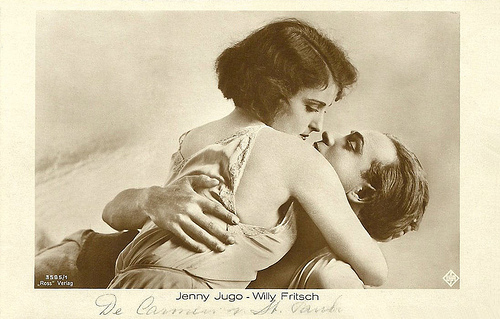
German postcard by Ross Verlag, no. 3585/1, 1928-1929. Photo: Jenny Jugo and Willy Fritsch in Die Carmen von St. Pauli/Docks of Hamburg (Erich Waschneck, 1928).
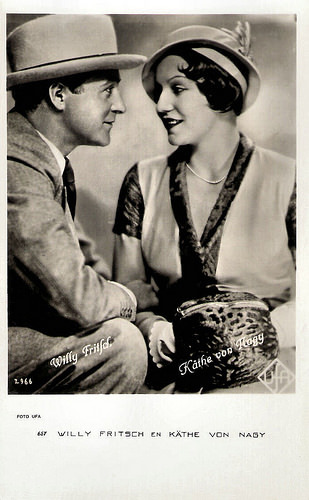
Dutch postcard, no. 657. Photo: Ufa. Willy Fritsch and Käthe von Nagy played together in several films of the early 1930s, such as Ihre Hoheit befehlt (Hanns Schwarz, 1930/1931), Ronny (Reinhold Schünzel, 1931) and Ich bei Tag und du bei Nacht (Ludwig Berger, 1932).

German postcard by Ross Verlag, no. 143/6, 1925-1935. Photo: Ufa. Willi Forst , Lilian Harvey and Willy Fritsch in the musical comedy Ein blonder Traum/Happy Ever After (Paul Martin, 1932).
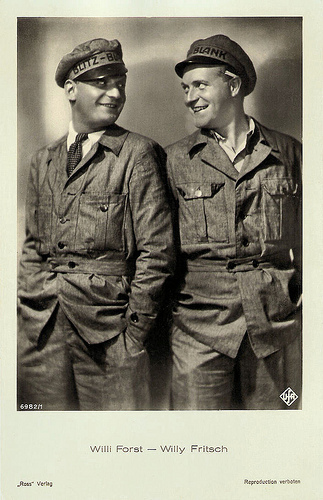
German postcard by Ross Verlag, no. 6982/1, 1931-1932. Photo: Ufa. Publicity still of Willi Forst and Willy Fritsch in the musical comedy Ein blonder Traum/Happy Ever After (Paul Martin, 1932).
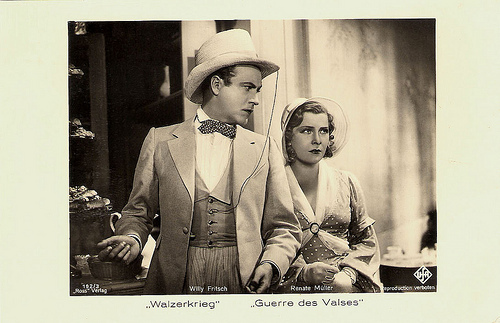
German postcard by Ross Verlag, no. 192/3, 1932-1933. Photo: Ufa. Publicity still for Walzerkrieg/Waltz Time in Vienna (Ludwig Berger, 1933) with Willy Fritsch and Renate Müller . Collection: Egbert Barten.
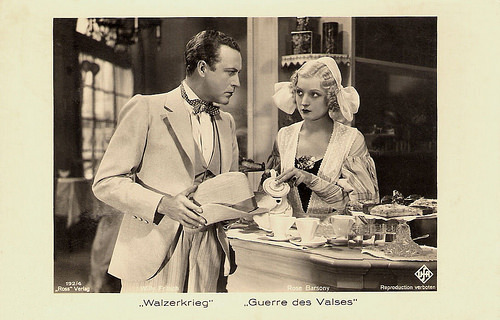
German postcard by Ross Verlag, no. 192/4, 1925-1925. Photo: Ufa. Publicity still for Walzerkrieg (Ludwig Berger, 1933) with Rose Barsony and Willy Fritsch .
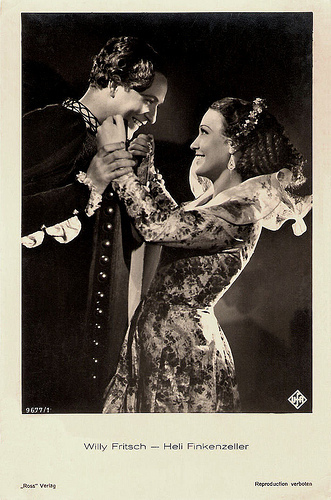
German postcard by Ross Verlag, no. 9677/1, 1935-1936. Photo: Ufa. Publicity still for Boccaccio (Herbert Maisch, 1936) with Heli Finkenzeller and Willy Fritsch .
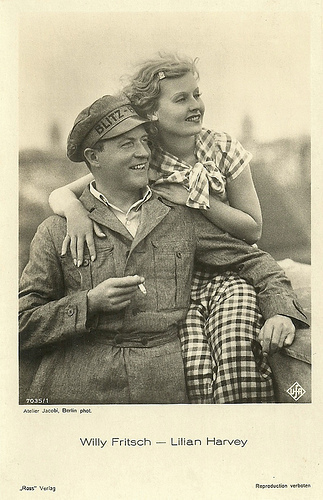
German postcard by Ross Verlag, no. 7035/1, 1931-1932. Photo: Atelier Jacobi, Berlin / Ufa. Publicity still for Ein blonder Traum/Happy Ever After (Paul Martin, 1932) with Willy Fritsch and Lilian Harvey .
This is a post for Postcard Friendship Friday, hosted by Beth at the The Best Hearts are Crunchy. You can visit her by clicking on the button below.


Willy Fritsch . German postcard by Ross Verlag, no. 6746/1, 1931-1932. Photo: Ufa.

German postcard by Ross Verlag, no. 48/5, 1925-1926. Photo: Ufa. Publicity still for Ein Walzertraum/The Waltz Dream (Ludwig Berger, 1925) with Xenia Desni and Willy Fritsch .

French postcard by ACE. Photo: Ufa. Suzy Vernon and Willy Fritsch in the German operetta film Der letzte Walzer/The Last Waltz (Arthur Robison, 1927).

German postcard by Ross Verlag, no. 104/3, 1925-1935. Photo: Ufa. Publicity still for Ungarische Rhapsodie/Hungarian Rhapsody (Hanns Schwarz, 1928) with Willy Fritsch and Dita Parlo .

German postcard by Ross Verlag, no. 3585/1, 1928-1929. Photo: Jenny Jugo and Willy Fritsch in Die Carmen von St. Pauli/Docks of Hamburg (Erich Waschneck, 1928).

Dutch postcard, no. 657. Photo: Ufa. Willy Fritsch and Käthe von Nagy played together in several films of the early 1930s, such as Ihre Hoheit befehlt (Hanns Schwarz, 1930/1931), Ronny (Reinhold Schünzel, 1931) and Ich bei Tag und du bei Nacht (Ludwig Berger, 1932).

German postcard by Ross Verlag, no. 143/6, 1925-1935. Photo: Ufa. Willi Forst , Lilian Harvey and Willy Fritsch in the musical comedy Ein blonder Traum/Happy Ever After (Paul Martin, 1932).

German postcard by Ross Verlag, no. 6982/1, 1931-1932. Photo: Ufa. Publicity still of Willi Forst and Willy Fritsch in the musical comedy Ein blonder Traum/Happy Ever After (Paul Martin, 1932).

German postcard by Ross Verlag, no. 192/3, 1932-1933. Photo: Ufa. Publicity still for Walzerkrieg/Waltz Time in Vienna (Ludwig Berger, 1933) with Willy Fritsch and Renate Müller . Collection: Egbert Barten.

German postcard by Ross Verlag, no. 192/4, 1925-1925. Photo: Ufa. Publicity still for Walzerkrieg (Ludwig Berger, 1933) with Rose Barsony and Willy Fritsch .

German postcard by Ross Verlag, no. 9677/1, 1935-1936. Photo: Ufa. Publicity still for Boccaccio (Herbert Maisch, 1936) with Heli Finkenzeller and Willy Fritsch .

German postcard by Ross Verlag, no. 7035/1, 1931-1932. Photo: Atelier Jacobi, Berlin / Ufa. Publicity still for Ein blonder Traum/Happy Ever After (Paul Martin, 1932) with Willy Fritsch and Lilian Harvey .
This is a post for Postcard Friendship Friday, hosted by Beth at the The Best Hearts are Crunchy. You can visit her by clicking on the button below.

Published on February 25, 2016 22:00
February 24, 2016
Elizza La Porta
Romanian born actress Elizza La Porta (1904-1997) had a short lived career in the late silent cinema of Germany. Her main claim of fame was her starring role in Der Student von Prag/The Man Who Cheated Life (1926).
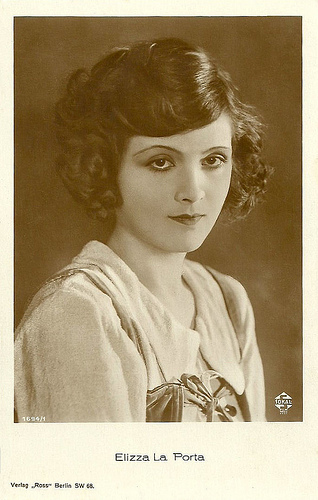
German postcard by Ross Verlag, no. 1694/1, 1927-1928. Photo: Sokal Film. Sokal produced Der Student von Prag/The Man Who Cheated Life (1926).
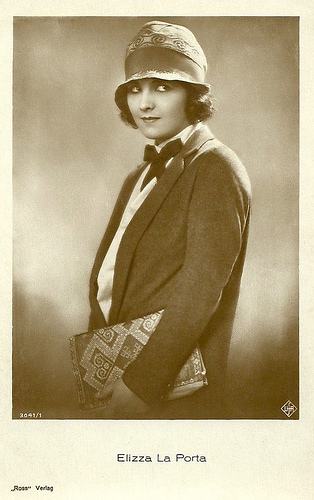
German postcard by Ross Verlag, no. 3041/1, 1928-1929. Photo: Ufa.
Doppelgänger
Elizza La Porta was born in Craiova, Romania, in 1902. (Some sources say 1904).
She started her film career in 1926 in such German productions as Schenk mir das Leben/Give me the life (Klaus Fery, 1926), Der Herr der Nacht/Man of the Night (Carl Heinz Wolff, 1926) starring Rudolf Klein-Rogge , and the comedy Die Spork'schen Jäger/The Secret of the Night (Holger-Madsen, 1926) with Otto Gebühr and Walter Rilla .
La Porta flamed in the horror film Der Student von Prag/The Man Who Cheated Life (Henrik Galeen, 1926) as the flower girl Lyduschka, who is in love with the student Balduin ( Conrad Veidt ). The penniless Balduin sells his mirror image to a mysterious merchant ( Werner Krauss ), and his reflection becomes a devilish Doppelgänger.
This first remake of the classic film from 1913 with Paul Wegener is largely based on the original screenplay by Hanns Heinz Ewers. Der Student von Prag made La Porta a well-known actress.
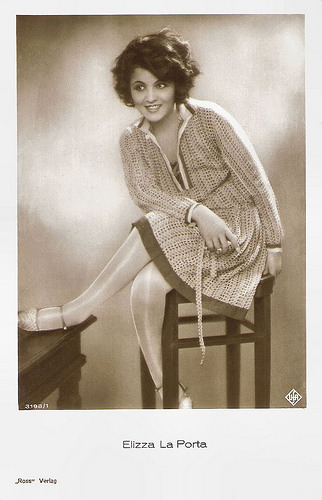
German postcard by Ross Verlag, no. 3198/1 1928-1929. Photo: Ufa.
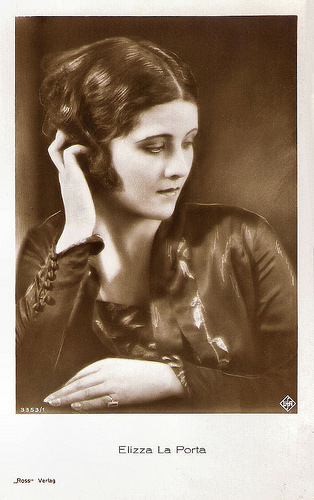
German postcard by Ross Verlag, no. 3353/1, 1928-1929. Photo: Ufa.
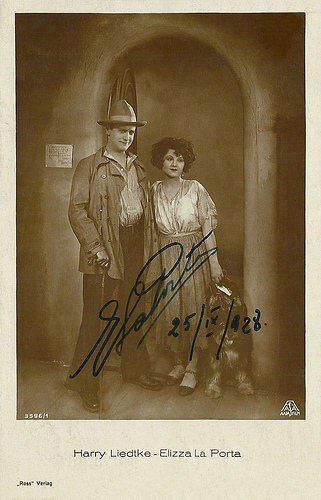
German postcard by Ross Verlag, no. 3596/1, 1928-1929 (Autograph of La Porta signed in 1928). Photo: Aafa-Film. Publicity still for the comedy Robert und Bertram/Robert and Bertram (Rudolf Walther-Fein, 1928) with Harry Liedtke . Collection: Didier Hanson
Sound
Subsequently, Elizza La Porta acted in films like Leichte Kavallerie/Light Cavalry (Rolf Randolf, 1927) with Alphons Fryland , and Laster der Menschheit/Vice of Mankind (Rudolf Meinert, 1927) with Asta Nielsen .
The next year she played in Die Frauengasse von Algier/The Street of Women of Algiers (Wolfgang Hoffmann-Harnisch, 1928) with Maria Jacobini , and Robert und Bertram/Robert and Bertram (Rudolf Walther-Fein, 1928) with Harry Liedtke and Fritz Kampers.
In the late 1920s La Porta played female leads in a few German sound films including Engel im Separée (Ernö Mayer, 1929), and Grossstadtpiraten/Big City Pirates (Hans Schönlank, 1930).
Her last film appearance was a supporting part in Fundvogel/Finding bird (Wolfgang Hoffmann-Harnisch, 1930), starring Paul Wegener and Camilla Horn .
When sound film arrived, Elizza La Porta completely retired from film acting. During her four year career she had made 18 films.
About the rest of her life we could not find information on the net. The only known fact is that she died in 1997 in West Hollywood, Los Angeles, California, USA. She was 95.
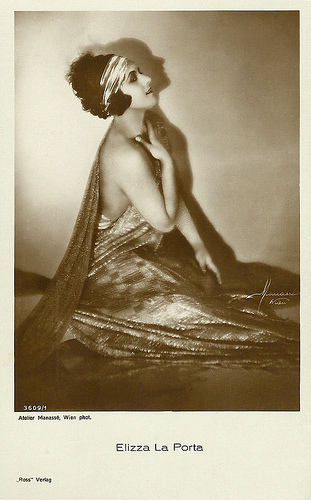
German postcard by Ross Verlag, no. 3609/1. Photo: Atelier Manassé, Wien (Vienna). Collection: Didier Hanson.
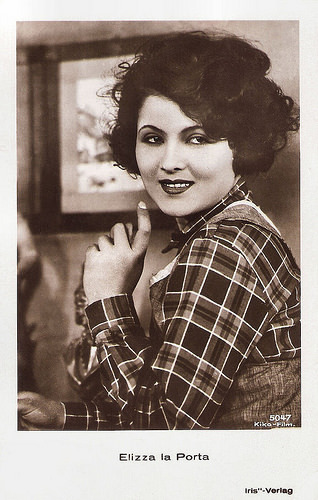
Austrian postcard by Iris-Verlag, no. 5047. Photo: Kiko-Film.
First scenes of Der Student von Prag/The Man Who Cheated Life (1926). Source: Silent Film Democracy (YouTube).
Sources: Thomas Staedeli (Cyranos), Filmportal.de, and .

German postcard by Ross Verlag, no. 1694/1, 1927-1928. Photo: Sokal Film. Sokal produced Der Student von Prag/The Man Who Cheated Life (1926).

German postcard by Ross Verlag, no. 3041/1, 1928-1929. Photo: Ufa.
Doppelgänger
Elizza La Porta was born in Craiova, Romania, in 1902. (Some sources say 1904).
She started her film career in 1926 in such German productions as Schenk mir das Leben/Give me the life (Klaus Fery, 1926), Der Herr der Nacht/Man of the Night (Carl Heinz Wolff, 1926) starring Rudolf Klein-Rogge , and the comedy Die Spork'schen Jäger/The Secret of the Night (Holger-Madsen, 1926) with Otto Gebühr and Walter Rilla .
La Porta flamed in the horror film Der Student von Prag/The Man Who Cheated Life (Henrik Galeen, 1926) as the flower girl Lyduschka, who is in love with the student Balduin ( Conrad Veidt ). The penniless Balduin sells his mirror image to a mysterious merchant ( Werner Krauss ), and his reflection becomes a devilish Doppelgänger.
This first remake of the classic film from 1913 with Paul Wegener is largely based on the original screenplay by Hanns Heinz Ewers. Der Student von Prag made La Porta a well-known actress.

German postcard by Ross Verlag, no. 3198/1 1928-1929. Photo: Ufa.

German postcard by Ross Verlag, no. 3353/1, 1928-1929. Photo: Ufa.

German postcard by Ross Verlag, no. 3596/1, 1928-1929 (Autograph of La Porta signed in 1928). Photo: Aafa-Film. Publicity still for the comedy Robert und Bertram/Robert and Bertram (Rudolf Walther-Fein, 1928) with Harry Liedtke . Collection: Didier Hanson
Sound
Subsequently, Elizza La Porta acted in films like Leichte Kavallerie/Light Cavalry (Rolf Randolf, 1927) with Alphons Fryland , and Laster der Menschheit/Vice of Mankind (Rudolf Meinert, 1927) with Asta Nielsen .
The next year she played in Die Frauengasse von Algier/The Street of Women of Algiers (Wolfgang Hoffmann-Harnisch, 1928) with Maria Jacobini , and Robert und Bertram/Robert and Bertram (Rudolf Walther-Fein, 1928) with Harry Liedtke and Fritz Kampers.
In the late 1920s La Porta played female leads in a few German sound films including Engel im Separée (Ernö Mayer, 1929), and Grossstadtpiraten/Big City Pirates (Hans Schönlank, 1930).
Her last film appearance was a supporting part in Fundvogel/Finding bird (Wolfgang Hoffmann-Harnisch, 1930), starring Paul Wegener and Camilla Horn .
When sound film arrived, Elizza La Porta completely retired from film acting. During her four year career she had made 18 films.
About the rest of her life we could not find information on the net. The only known fact is that she died in 1997 in West Hollywood, Los Angeles, California, USA. She was 95.

German postcard by Ross Verlag, no. 3609/1. Photo: Atelier Manassé, Wien (Vienna). Collection: Didier Hanson.

Austrian postcard by Iris-Verlag, no. 5047. Photo: Kiko-Film.
First scenes of Der Student von Prag/The Man Who Cheated Life (1926). Source: Silent Film Democracy (YouTube).
Sources: Thomas Staedeli (Cyranos), Filmportal.de, and .
Published on February 24, 2016 22:00
February 23, 2016
Imported from the USA: Tab Hunter
With his blond, tanned, surfer-boy good looks, Tab Hunter (1931) was one of Hollywood’s hottest teen idols of the 1950s era. The American actor, singer, and author portrayed boy-next-door marines, cowboys and swoon-bait sweethearts, and had a huge hit with the song Young Love (1957). When his career faded during the 1960s, he starred in Italy in Spaghetti Westerns. In the 1980s Hunter returned in the camp classics Polyester (1981) and Lust in the Dust (1985).

Spanish postcard by Archivo Bermejo, no. 5495. Photo: Warner Bros. Publicity still for Lafayette Escadrille (William A Wellman, 1958).
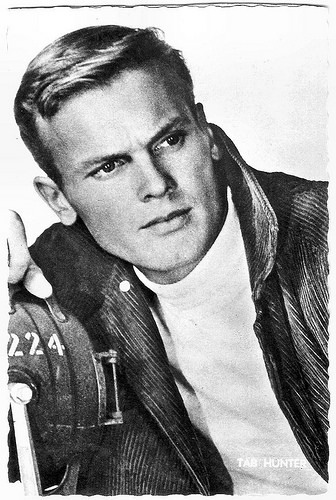
Dutch postcard by Int. Filmpers (IFP), Amsterdam, no. 1144.

Vintage postcard, no. 2311.
Fetching handsomeness and trim, athletic physique
Tab Hunter was born Arthur Andrew Kelm in New York City, in 1931. He is the son of Gertrude (Gelien) and Charles Kelm. Hunter's father was an abusive man and within a few years of his birth, his parents divorced and his mother moved with her two sons to California. Tab’s older brother Walter John Gelien (1930) would die in Vietnam in 1965 leaving seven children.
As a teenager, Hunter was a figure skater, competing in both singles and pairs. He joined the U.S. Coast Guard at the age of 15, lying about his age to enlist. While in the Coast Guard, he gained the nickname ‘Hollywood’ for his penchant for watching movies rather than going to bars while on liberty. He was eventually discharged when the age deception was revealed.
Returning home, his life-long passion for horseback riding led to a job with a riding academy. He was given the stage name Tab Hunter by his first agent, Henry Willson. With no previous experience Tab made his first, albeit minor, film debut in the racially trenchant drama The Lawless (Joseph Losey, 1950) starring Gail Russell. His fetching handsomeness and trim, athletic physique landed him a role in the British production Saturday Island (Stuart Heisler, 1952) opposite Linda Darnell. His shirt remained off for a good portion of the film, which certainly did not go unnoticed, and he was signed by Warner Bros.
The Hollywood studio system artificially groomed him and nicknamed him ‘The Sigh Guy’. His co-starring role as young Marine Danny in the World War II drama Battle Cry (Raoul Walsh, 1955), made him one of Hollywood's top young romantic leads. In the film based on the Leon Uris novel, Hunter has an affair with an older woman (Dorothy Malone), but ends up marrying the girl next door (Mona Freeman).
In September 1955, the tabloid magazine Confidential reported Hunter's 1950 arrest following an L.A. raid on a ‘pajama party’ in Walnut Park. Tab was eventually fined $50 for a reduced ‘disorderly conduct’ charge after originally being charged with ‘idle, lewd or dissolute conduct.’ The article, and a second one focusing on Rory Calhoun's prison record, were the result of a deal Henry Willson had brokered with Confidential in exchange for not revealing his client Rock Hudson's sexual orientation.
Surprisingly this article had no negative effect on Hunter's career. His hit films of these years include The Burning Hills (Stuart Heisler, 1955) with Natalie Wood, The Girl He Left Behind (David Butler, 1956), and Gunman’s Walk (Phil Karlson, 1957) with Van Heflin. Hunter, James Dean, and Natalie Wood were the last of the actors placed under exclusive studio contract to Warner Bros.
In 1957, Hunter had a hit record with the song Young Love, which was #1 on the Billboard Hot 100 chart for six weeks and became one of the larger hits of the Rock & Roll era. Another hit record was Ninety-Nine Ways, which peaked at #11. His success prompted Jack L. Warner to enforce the actor's contract with the Warner Bros. studio by banning Dot Records, the label for which Hunter had recorded the single (and which was owned by rival Paramount Pictures), from releasing a follow-up album he had recorded for them. He established Warner Bros. Records specifically for Hunter.
In 1958, Hunter starred in the musical film Damn Yankees (George Abbott, Stanley Donen, 1958), in which he played Joe Hardy of Washington DC's American League baseball club. Another success was That Kind of Woman (Sidney Lumet, 1959) with Sophia Loren . Hunter was Warner Bros.' top money-grossing star from 1955 through 1959.
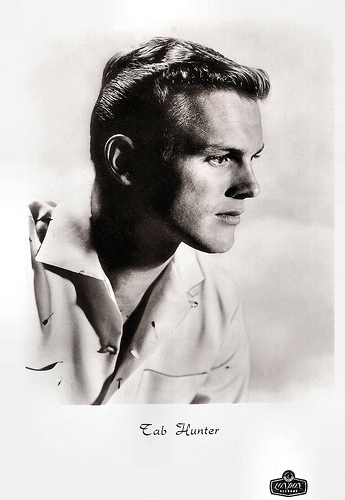
Dutch postcard by Gebr. Spanjersberg N.V., Rotterdam / Editions Altona, Amsterdam, no. 5128. Photo: London Records.
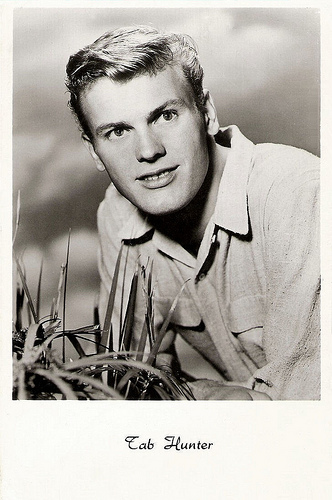
Dutch postcard by Gebr. Spanjersberg N.V., Rotterdam. Photo: Warner Bros Pictures.
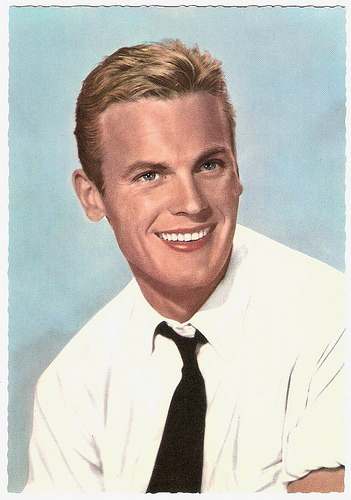
German postcard by ISV, no. H 51.
Spoofing his old clean-cut image
Tab Hunter's failure to win the role of Tony in the film adaptation of West Side Story (Jerome Robbins, Robert Wise, 1961) prompted him to agree to star in a weekly television sitcom. In 1960, prior to the program's debut, he was arrested by the police for allegedly beating his dog Fritz. His 11-day trial started in mid-October, a month after The Tab Hunter Show debuted on on NBC. The neighbour who initiated the charges had done so for spite when Hunter declined her repeated invitations to dinner, and he was acquitted by the jury. The Tab Hunter Show had moderate ratings and was cancelled after one season.
Following the film comedy The Pleasure of His Company (George Seaton, 1961) opposite Debbie Reynolds, the quality of his films fell off drastically during the 1960s. In Italy he made the fantasy L'arciere delle mille e una notte/The Golden Arrow (Antonio Margheriti, 1962) with Rossana Podestà . In Great Britain he starred in The City Under the Sea (Jacques Tourneur, 1965) with Vincent Price. For a short time in the late 1960s, after several seasons of starring in summer stock and dinner theatre in shows such as Bye Bye Birdie, The Tender Trap and Under the Yum Yum Tree.
Hunter settled in the south of France, and acted in Spaghetti Westerns like El dedo del destino/The Cups of San Sebastian (Richard Rush, 1967) and La vendetta è il mio perdono/Shotgun (Roberto Mauri, 1968). During the 1970 he worked mainly for TV but also starred in the horror film Sweet Kill (Curtis Hanson, 1972) and appeared in the Western The Life and Times of Judge Roy Bean (John Huston, 1972).
His career was revived in the 1980s, when he spoofed his old clean-cut image by appearing opposite Divine in the camp classics Polyester (John Waters, 1981) and Lust in the Dust (Paul Bartel, 1985), which Hunter also co-produced. He then played Mr. Stewart, the substitute teacher in Grease 2 (Patricia Birch, 1982), who sang Reproduction. Hunter had a major role in the horror film Cameron's Closet (Armand Mastroianni, 1988). He also wrote, co-produced and starred in Dark Horse (David Hemmings, 1992).
Hunter's autobiography, Tab Hunter Confidential: The Making of a Movie Star (2006), co-written with Eddie Muller, became a New York Times best-seller as did the paperback edition in 2007. In the book, he acknowledged that he is gay, confirming rumours that had circulated since the height of his fame. According to William L. Hamilton of The New York Times, detailed reports about Hunter's alleged romances with close friends Debbie Reynolds and Natalie Wood, were strictly the fodder of studio publicity departments. Hunter had a long-term relationship with actor Anthony Perkins and shorter flings with dancer Rudolf Nureyev and champion figure skater Ronnie Robertson, before settling down with his partner of over 30 years, Allan Glaser.
In 2015 Glaser produced the documentary Tab Hunter Confidential (Jeffrey Schwarz, 2015), based on Hunter’s autobiography, which re-entered the New York Times Best Seller list during the release of the documentary.
Trailer for Damn Yankees (1958). Source: Tab Hunter (YouTube).
Tab Hunter sings Young Love Live at The Perry Como Show. Source: The Land Of Marcos (YouTube).
Trailer Polyester (1981). Source: Night of the Trailers (YouTube).
Trailer Tab Hunter Confidential (2015). Source: Vanity Fair (YouTube).
Sources: (IMDb), Wikipedia, and .

Spanish postcard by Archivo Bermejo, no. 5495. Photo: Warner Bros. Publicity still for Lafayette Escadrille (William A Wellman, 1958).

Dutch postcard by Int. Filmpers (IFP), Amsterdam, no. 1144.

Vintage postcard, no. 2311.
Fetching handsomeness and trim, athletic physique
Tab Hunter was born Arthur Andrew Kelm in New York City, in 1931. He is the son of Gertrude (Gelien) and Charles Kelm. Hunter's father was an abusive man and within a few years of his birth, his parents divorced and his mother moved with her two sons to California. Tab’s older brother Walter John Gelien (1930) would die in Vietnam in 1965 leaving seven children.
As a teenager, Hunter was a figure skater, competing in both singles and pairs. He joined the U.S. Coast Guard at the age of 15, lying about his age to enlist. While in the Coast Guard, he gained the nickname ‘Hollywood’ for his penchant for watching movies rather than going to bars while on liberty. He was eventually discharged when the age deception was revealed.
Returning home, his life-long passion for horseback riding led to a job with a riding academy. He was given the stage name Tab Hunter by his first agent, Henry Willson. With no previous experience Tab made his first, albeit minor, film debut in the racially trenchant drama The Lawless (Joseph Losey, 1950) starring Gail Russell. His fetching handsomeness and trim, athletic physique landed him a role in the British production Saturday Island (Stuart Heisler, 1952) opposite Linda Darnell. His shirt remained off for a good portion of the film, which certainly did not go unnoticed, and he was signed by Warner Bros.
The Hollywood studio system artificially groomed him and nicknamed him ‘The Sigh Guy’. His co-starring role as young Marine Danny in the World War II drama Battle Cry (Raoul Walsh, 1955), made him one of Hollywood's top young romantic leads. In the film based on the Leon Uris novel, Hunter has an affair with an older woman (Dorothy Malone), but ends up marrying the girl next door (Mona Freeman).
In September 1955, the tabloid magazine Confidential reported Hunter's 1950 arrest following an L.A. raid on a ‘pajama party’ in Walnut Park. Tab was eventually fined $50 for a reduced ‘disorderly conduct’ charge after originally being charged with ‘idle, lewd or dissolute conduct.’ The article, and a second one focusing on Rory Calhoun's prison record, were the result of a deal Henry Willson had brokered with Confidential in exchange for not revealing his client Rock Hudson's sexual orientation.
Surprisingly this article had no negative effect on Hunter's career. His hit films of these years include The Burning Hills (Stuart Heisler, 1955) with Natalie Wood, The Girl He Left Behind (David Butler, 1956), and Gunman’s Walk (Phil Karlson, 1957) with Van Heflin. Hunter, James Dean, and Natalie Wood were the last of the actors placed under exclusive studio contract to Warner Bros.
In 1957, Hunter had a hit record with the song Young Love, which was #1 on the Billboard Hot 100 chart for six weeks and became one of the larger hits of the Rock & Roll era. Another hit record was Ninety-Nine Ways, which peaked at #11. His success prompted Jack L. Warner to enforce the actor's contract with the Warner Bros. studio by banning Dot Records, the label for which Hunter had recorded the single (and which was owned by rival Paramount Pictures), from releasing a follow-up album he had recorded for them. He established Warner Bros. Records specifically for Hunter.
In 1958, Hunter starred in the musical film Damn Yankees (George Abbott, Stanley Donen, 1958), in which he played Joe Hardy of Washington DC's American League baseball club. Another success was That Kind of Woman (Sidney Lumet, 1959) with Sophia Loren . Hunter was Warner Bros.' top money-grossing star from 1955 through 1959.

Dutch postcard by Gebr. Spanjersberg N.V., Rotterdam / Editions Altona, Amsterdam, no. 5128. Photo: London Records.

Dutch postcard by Gebr. Spanjersberg N.V., Rotterdam. Photo: Warner Bros Pictures.

German postcard by ISV, no. H 51.
Spoofing his old clean-cut image
Tab Hunter's failure to win the role of Tony in the film adaptation of West Side Story (Jerome Robbins, Robert Wise, 1961) prompted him to agree to star in a weekly television sitcom. In 1960, prior to the program's debut, he was arrested by the police for allegedly beating his dog Fritz. His 11-day trial started in mid-October, a month after The Tab Hunter Show debuted on on NBC. The neighbour who initiated the charges had done so for spite when Hunter declined her repeated invitations to dinner, and he was acquitted by the jury. The Tab Hunter Show had moderate ratings and was cancelled after one season.
Following the film comedy The Pleasure of His Company (George Seaton, 1961) opposite Debbie Reynolds, the quality of his films fell off drastically during the 1960s. In Italy he made the fantasy L'arciere delle mille e una notte/The Golden Arrow (Antonio Margheriti, 1962) with Rossana Podestà . In Great Britain he starred in The City Under the Sea (Jacques Tourneur, 1965) with Vincent Price. For a short time in the late 1960s, after several seasons of starring in summer stock and dinner theatre in shows such as Bye Bye Birdie, The Tender Trap and Under the Yum Yum Tree.
Hunter settled in the south of France, and acted in Spaghetti Westerns like El dedo del destino/The Cups of San Sebastian (Richard Rush, 1967) and La vendetta è il mio perdono/Shotgun (Roberto Mauri, 1968). During the 1970 he worked mainly for TV but also starred in the horror film Sweet Kill (Curtis Hanson, 1972) and appeared in the Western The Life and Times of Judge Roy Bean (John Huston, 1972).
His career was revived in the 1980s, when he spoofed his old clean-cut image by appearing opposite Divine in the camp classics Polyester (John Waters, 1981) and Lust in the Dust (Paul Bartel, 1985), which Hunter also co-produced. He then played Mr. Stewart, the substitute teacher in Grease 2 (Patricia Birch, 1982), who sang Reproduction. Hunter had a major role in the horror film Cameron's Closet (Armand Mastroianni, 1988). He also wrote, co-produced and starred in Dark Horse (David Hemmings, 1992).
Hunter's autobiography, Tab Hunter Confidential: The Making of a Movie Star (2006), co-written with Eddie Muller, became a New York Times best-seller as did the paperback edition in 2007. In the book, he acknowledged that he is gay, confirming rumours that had circulated since the height of his fame. According to William L. Hamilton of The New York Times, detailed reports about Hunter's alleged romances with close friends Debbie Reynolds and Natalie Wood, were strictly the fodder of studio publicity departments. Hunter had a long-term relationship with actor Anthony Perkins and shorter flings with dancer Rudolf Nureyev and champion figure skater Ronnie Robertson, before settling down with his partner of over 30 years, Allan Glaser.
In 2015 Glaser produced the documentary Tab Hunter Confidential (Jeffrey Schwarz, 2015), based on Hunter’s autobiography, which re-entered the New York Times Best Seller list during the release of the documentary.
Trailer for Damn Yankees (1958). Source: Tab Hunter (YouTube).
Tab Hunter sings Young Love Live at The Perry Como Show. Source: The Land Of Marcos (YouTube).
Trailer Polyester (1981). Source: Night of the Trailers (YouTube).
Trailer Tab Hunter Confidential (2015). Source: Vanity Fair (YouTube).
Sources: (IMDb), Wikipedia, and .
Published on February 23, 2016 22:00
February 22, 2016
Suzy Prim
Suzy Prim (1895-1991) was an acclaimed French actress, both on stage and on screen. As a young girl she already appeared as La petite Arduini in short silent films by Louis Feuillade. The height of her popularity was in the 1930s. Prim also produced films and wrote scripts.
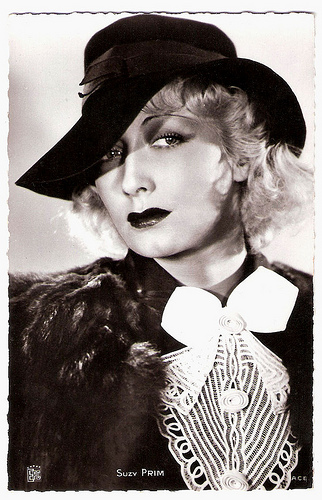
French postcard by Editions en Publications Cinematographiques (EPC), no. 160. Photo: ACE.
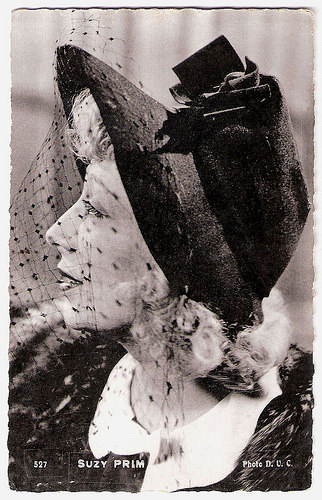
French postcard by Edit. Chantal, Paris, no. 527. Photo: D.U.C.
Child Actor
Suzy Prim was born as Suzanne Mariette Arduini in Paris in 1895. She was the daughter of Gaston Arduini, an artist who belonged to an Italian family of actors and pantomime players who had established themselves in France in the 17th century.
Suzanne played on stage from a very early age on. She visited the Théàtre de l’Oeuvre by Aurélien Lugné-Poë, where she developped artistically. She would dedicate most of her life to the theatre and proved to be one of the best French female performers, often reciting next to Sacha Guitry and Jules Berry . With Berry she also shared her life for a while.
At a young age Prim was discovered by pioneer film director Louis Feuillade who directed her in the silent short Petits poèmes antiques/Little Antic Poems (Louis Feuillade, 1910). She became the ‘girl-actress’ in many of his films for Gaumont. Under the name of La petite Arduini, she was paired with that other child actor René Dary in such films as Le petit poucet/Tom Thumb (Louis Feuillade, 1912).
In 1914 she played in the Italian-Spanish coproduction Carmen (Giovanni Doria, Augusto Turqui, 1914), produced by Cines. This resulted in performances in various Italian films in 1914 and 1915: Madame Coralie & Cie/Coralie & C.ie (1914) starring Lea Giunchi , La beffa atroce (Carmine Gallone, 1915) with Soava Gallone , and Papà (Nino Oxilia, 1915) with Pina Menichelli .
Back in France, Prim did a whole series of films with director Georges-André Lacroix and when he moved to Italy to film, she followed him there, playing in titles like Appassionatamente/Passionately (Georges-André Lacroix, 1919) and Il suo destino/His Destiny (Georges-André Lacroix, 1921). In 1922 she played opposite Cyprian Gilles in L’aiglonne/The Eagle, a serial of 12 episodes, directed by René Navarre and Emile Keppens. After that Prim abandoned cinema, and focused on her stage career.
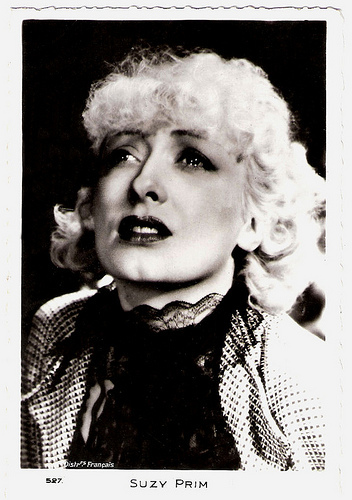
French postcard by Collection Chantal, Paris, no. 527. Photo: Distributeurs Français.
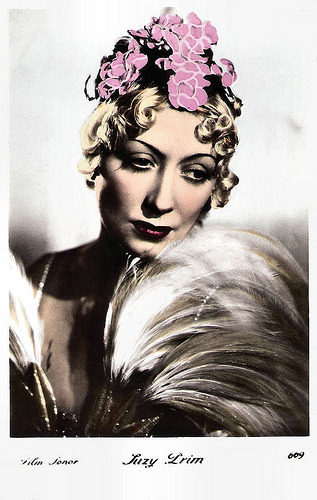
French postcard, no. 669. Photo: Film Sonor.
Vengeful Empress
Suzy Prim’s film career took a new turn when sound arrived. Prim became a leading lady of the French cinema, first in films with Jules Berry in the lead such as Mon coeur et ses millions/My Love and His Millions (André Berthomieu, 1931). Between 1935 and 1940 Prim played in some 30 films, ranging from comedy such as the Fernandel vehicle Un de la légion/One of the Legion (Christian Jaque, 1936) to drama, as the Stefan Zweig adaptation La peur/The Fright (Victor Tourjansky, 1936).
Roles of particular importance were the matchmaking countess in Mayerling (Anatole Litvak, 1935) who couples crownprince Rudolph ( Charles Boyer ) and young baroness Marie Vetsera ( Danielle Darrieux ), and Vassilissa, the woman whom Pepel ( Jean Gabin ) rejects in Jean Renoir’s adaptation of Maxim Gorki: Les bas-fonds/The Lower Depths (Jean Renoir, 1936).
Also memorable is Prim as Madame Tabasco, the star who falls for a pennyless gentleman in Alexis, gentleman chauffeur (Max de Vaucorbeil, 1938), and the vengeful empress Catherine II in the Italian film La principessa Tarakanova/Betrayal (Fedor Ozep, Mario Soldati, 1938), starring Annie Vernay as the fake heir to the Russian throne.
During the war Prim was active in comedies, a.o. with Raimu and Fernandel , but also played in dramas like the Emile Zola adaptation Au bonheur des dames/Shop Girls of Paris (André Cayatte, 1943) with Michel Simon , and the Honoré de Balzac adaptation La Rabouilleuse/The Black Sheep (Fernand Rivers, 1944) in which she played the title role.
In the postwar era Prim played in some fifteen other films, such as Au revoir M. Grock (Pierre Billon, 1949) with the famous Swiss clown Grock, and Au royaume des cieux (Julien Duvivier, 1949) with Serge Reggiani . From 1957 on Prim also produced films such as Douze heures d’horloge (Geza von Radvanyi, 1957) in which she also played, opposite Lino Ventura and Laurent Terzieff .
In the 1960s she appeared on television and wrote scripts for Pierre Bourdon, Jean Dréville and Jacques Derain, using her original name of Suzanne Arduini. Suzy Prim’s last screen performance was in Le corps de mon ennemi (Henri Verneuil, 1976) with Jean-Paul Belmondo .
At the very high age of 96, she died in Boulogne Billancourt (near Paris) in 1991. Suzy Prim lies buried at the cemetery of Belleville in Paris.
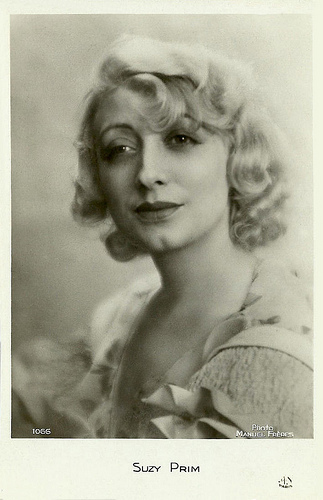
French postcard by A.N., Paris, no. 1066. Photo: Manuel Frères. Collection: Didier Hanson.
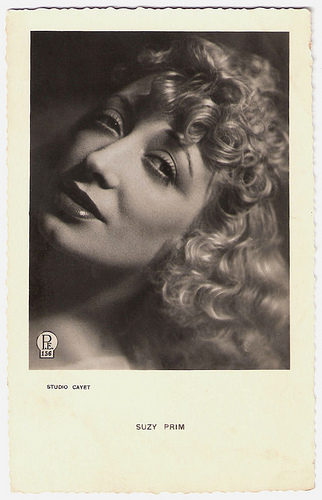
Belgian postcard by Photo Editions, no. 156. Photo: Studio Cayet. Jo Cayet (1907-1987) was a famous Brussels based photographer.
Sources: CineArtistes (French), Wikipedia (French and Italian), and .

French postcard by Editions en Publications Cinematographiques (EPC), no. 160. Photo: ACE.

French postcard by Edit. Chantal, Paris, no. 527. Photo: D.U.C.
Child Actor
Suzy Prim was born as Suzanne Mariette Arduini in Paris in 1895. She was the daughter of Gaston Arduini, an artist who belonged to an Italian family of actors and pantomime players who had established themselves in France in the 17th century.
Suzanne played on stage from a very early age on. She visited the Théàtre de l’Oeuvre by Aurélien Lugné-Poë, where she developped artistically. She would dedicate most of her life to the theatre and proved to be one of the best French female performers, often reciting next to Sacha Guitry and Jules Berry . With Berry she also shared her life for a while.
At a young age Prim was discovered by pioneer film director Louis Feuillade who directed her in the silent short Petits poèmes antiques/Little Antic Poems (Louis Feuillade, 1910). She became the ‘girl-actress’ in many of his films for Gaumont. Under the name of La petite Arduini, she was paired with that other child actor René Dary in such films as Le petit poucet/Tom Thumb (Louis Feuillade, 1912).
In 1914 she played in the Italian-Spanish coproduction Carmen (Giovanni Doria, Augusto Turqui, 1914), produced by Cines. This resulted in performances in various Italian films in 1914 and 1915: Madame Coralie & Cie/Coralie & C.ie (1914) starring Lea Giunchi , La beffa atroce (Carmine Gallone, 1915) with Soava Gallone , and Papà (Nino Oxilia, 1915) with Pina Menichelli .
Back in France, Prim did a whole series of films with director Georges-André Lacroix and when he moved to Italy to film, she followed him there, playing in titles like Appassionatamente/Passionately (Georges-André Lacroix, 1919) and Il suo destino/His Destiny (Georges-André Lacroix, 1921). In 1922 she played opposite Cyprian Gilles in L’aiglonne/The Eagle, a serial of 12 episodes, directed by René Navarre and Emile Keppens. After that Prim abandoned cinema, and focused on her stage career.

French postcard by Collection Chantal, Paris, no. 527. Photo: Distributeurs Français.

French postcard, no. 669. Photo: Film Sonor.
Vengeful Empress
Suzy Prim’s film career took a new turn when sound arrived. Prim became a leading lady of the French cinema, first in films with Jules Berry in the lead such as Mon coeur et ses millions/My Love and His Millions (André Berthomieu, 1931). Between 1935 and 1940 Prim played in some 30 films, ranging from comedy such as the Fernandel vehicle Un de la légion/One of the Legion (Christian Jaque, 1936) to drama, as the Stefan Zweig adaptation La peur/The Fright (Victor Tourjansky, 1936).
Roles of particular importance were the matchmaking countess in Mayerling (Anatole Litvak, 1935) who couples crownprince Rudolph ( Charles Boyer ) and young baroness Marie Vetsera ( Danielle Darrieux ), and Vassilissa, the woman whom Pepel ( Jean Gabin ) rejects in Jean Renoir’s adaptation of Maxim Gorki: Les bas-fonds/The Lower Depths (Jean Renoir, 1936).
Also memorable is Prim as Madame Tabasco, the star who falls for a pennyless gentleman in Alexis, gentleman chauffeur (Max de Vaucorbeil, 1938), and the vengeful empress Catherine II in the Italian film La principessa Tarakanova/Betrayal (Fedor Ozep, Mario Soldati, 1938), starring Annie Vernay as the fake heir to the Russian throne.
During the war Prim was active in comedies, a.o. with Raimu and Fernandel , but also played in dramas like the Emile Zola adaptation Au bonheur des dames/Shop Girls of Paris (André Cayatte, 1943) with Michel Simon , and the Honoré de Balzac adaptation La Rabouilleuse/The Black Sheep (Fernand Rivers, 1944) in which she played the title role.
In the postwar era Prim played in some fifteen other films, such as Au revoir M. Grock (Pierre Billon, 1949) with the famous Swiss clown Grock, and Au royaume des cieux (Julien Duvivier, 1949) with Serge Reggiani . From 1957 on Prim also produced films such as Douze heures d’horloge (Geza von Radvanyi, 1957) in which she also played, opposite Lino Ventura and Laurent Terzieff .
In the 1960s she appeared on television and wrote scripts for Pierre Bourdon, Jean Dréville and Jacques Derain, using her original name of Suzanne Arduini. Suzy Prim’s last screen performance was in Le corps de mon ennemi (Henri Verneuil, 1976) with Jean-Paul Belmondo .
At the very high age of 96, she died in Boulogne Billancourt (near Paris) in 1991. Suzy Prim lies buried at the cemetery of Belleville in Paris.

French postcard by A.N., Paris, no. 1066. Photo: Manuel Frères. Collection: Didier Hanson.

Belgian postcard by Photo Editions, no. 156. Photo: Studio Cayet. Jo Cayet (1907-1987) was a famous Brussels based photographer.
Sources: CineArtistes (French), Wikipedia (French and Italian), and .
Published on February 22, 2016 22:00
Paul van Yperen's Blog
- Paul van Yperen's profile
- 13 followers
Paul van Yperen isn't a Goodreads Author
(yet),
but they
do have a blog,
so here are some recent posts imported from
their feed.



